Eastern Australia Trip Report (Oct 8 – 24, 2025)
Day 1
We began the tour at Bay Village Retreat in Cairns, having a lovely dinner at the hotel and an early night ahead of an exciting day of birding.
Day 2
After an early breakfast at the hotel, we headed to Cattana Wetlands, just north of Cairns. It was a great start to the trip, with four Magpie Geese just next to the carpark and various Cormorants and Egrets on the lakes. Heading down the appropriately named Cuckoo Lane, we could hear an array of songbirds. A short wait produced excellent views of Little Bronze and Sahul Brush Cuckoos; Yellow, Brown and Brown-backed Honeyeaters; Varied Triller; Black-faced and Spectacled Monarchs and Leaden Flycatchers. A little further down the track we spotted two Bush Stone-Curlews and some Orange-footed Megapodes in the picnic area. Heading back to the car, we were treated to the amazing sight of four White-browed Crakes on the lillypads by the path along with several Comb-crested Jacanas.
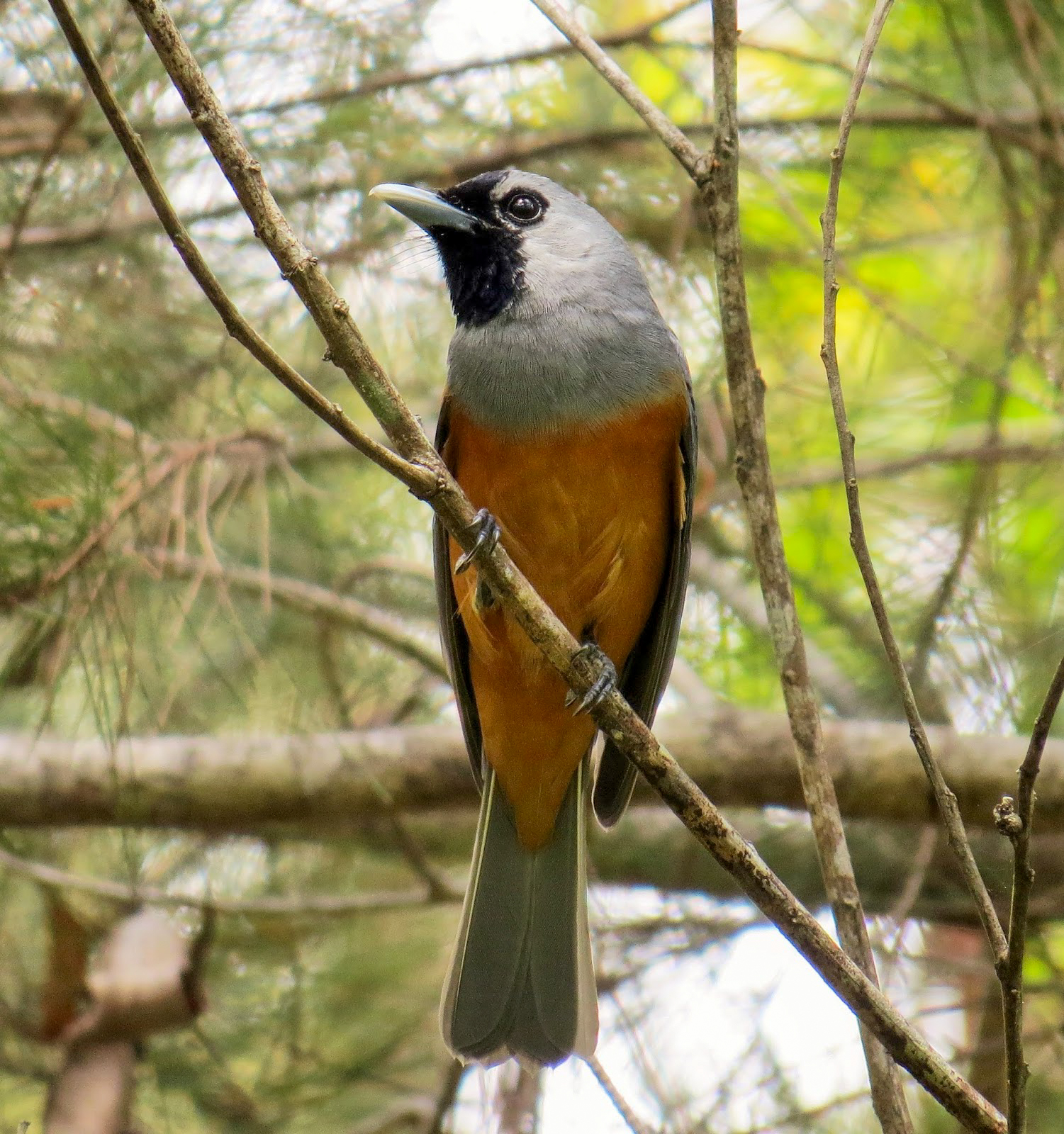
Black-faced Monarch © Gregor Tims
What was intended to be a short stop at nearby Redford Road Wetlands became a longer one as exciting birds kept appearing. Stunning flashes of red through the reeds revealed themselves as Crimson Finches, soon joined by Chestnut-breasted Mannikins, while an Osprey and Nankeen Kestrel went overhead. Metallic Starlings, Rainbow Lorikeets, Australasian Figbirds and White-breasted Orioles created a cacophony of noises. We soon spotted a beautiful pair of Green Pygmy Geese on the water, right next to another Comb-crested Jacana, before a magnificent Black-necked Stork soared overhead and thrilled all of us as it came down to land on the wetland. Taking turns to peek through the reeds, all the guests eventually enjoyed a great close-up view of this beautiful bird.
We then headed south to France Road Turf Farm. We had one primary target in mind, and quickly located it – a pair of Little Curlews showing close to the road. Nearby were beautiful Black-fronted Dotterels, dozens of Black and Whistling Kites, Australian Pipits, Golden-headed Cisticola and impressive White-bellied Sea Eagle and Black-necked Stork overhead.

Little Curlew © Gregor Tims
We headed back to Cairns, taking lunch near the Botanic Gardens. We soon went to the Saltwater Lake there, finding the male Rufous Owl roosting close to the path in his usual fig tree. New birds for the trip kept coming, including a skulking Striated Heron and a lovely Brahminy Kite soaring over the lakes. Guests also enjoyed close-up views of Australian Brushturkeys, while the sky was full of Australian Swiftlets and magnificent Torresian Imperial Pigeons. A friendly Black Butcherbird and a Sahul Sunbird provided a lovely supporting cast, before we moved on to Barron River Mouth in time for low tide.
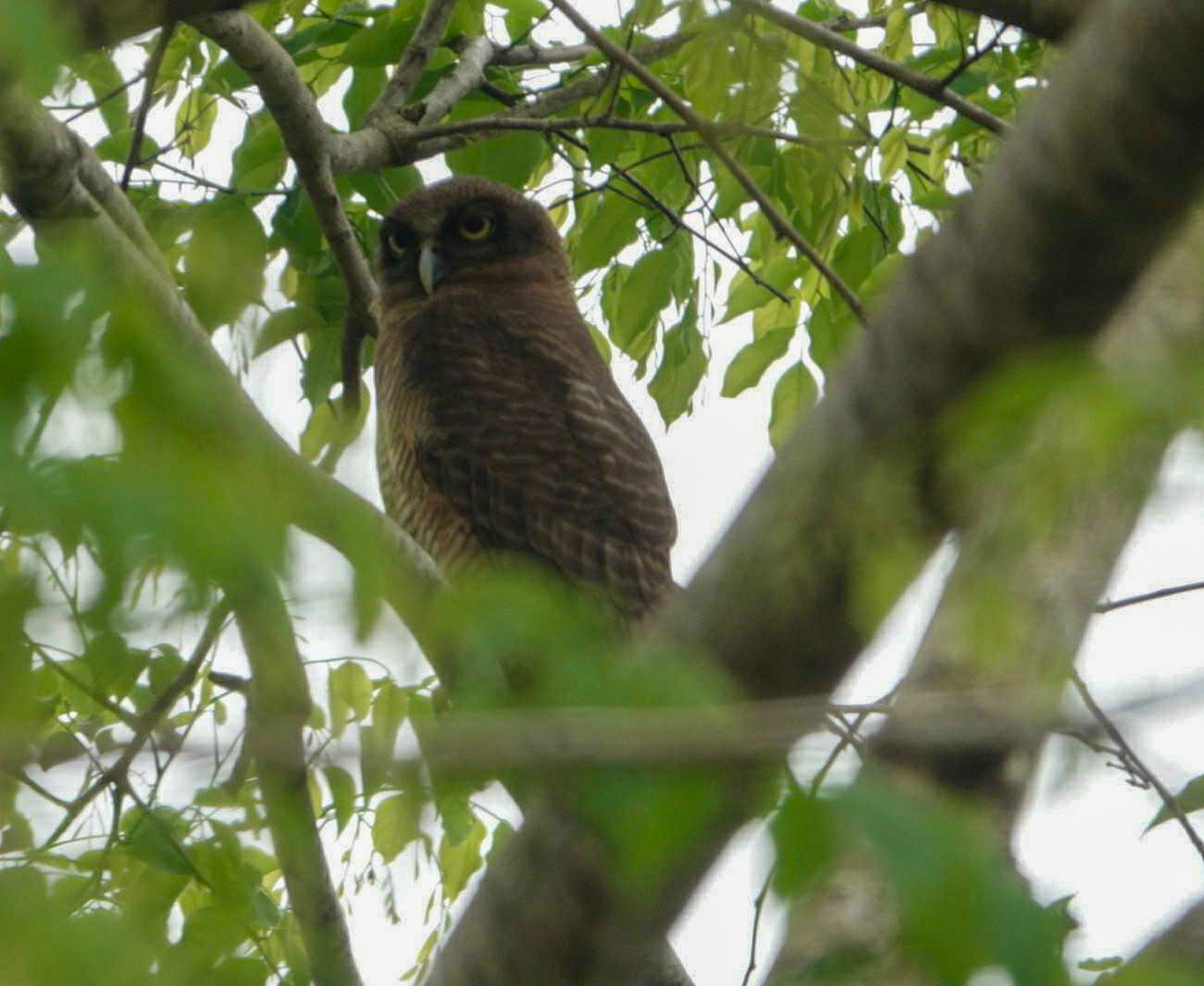
Rufous Owl © Jackdon Hagley
Barron River Mouth proved a brilliant end to the first day. Hundreds of waders were found on the beach, including both local breeders (Pied Oystercatcher and Red-capped Plover) and Siberian migrants, with especially large numbers of Pacific Golden Plover, Far Eastern Curlew, Whimbrel, Bar-tailed Godwit, Great Knot, Red-necked Stint and Grey-tailed Tattler. Terns were abundant – including both Greater and Lesser Crested, Little, Caspian and Australian. It was nice to pick out a single Common Tern amongst them, while a dark morph Pacific Reef Heron was a lovely sight among plentiful Egrets. Literally as we packed up the scopes to return to the car as darkness descended, a wonderful Beach Stone-Curlew flew past and landed on the opposite bank, capping off a brilliant first day of the tour with 93 species seen.

Beach Stone Curlew © Jackson Hagley
Day 3
After an early breakfast, we had a short walk around the southern end of Cairns Esplanade in search of shorebirds we had missed the previous day. A group of roosting Nankeen Night Herons made for an excellent start, joined in their tree by a very vocal Sacred Kingfisher, while multiple Bush Stone Curlews scuttled about the pathway. Looking out onto the Esplanade, we were treated to wonderful views of Royal Spoonbill and Australian Pelican, before a lovely Terek Sandpiper sprinted past a group of Sharp-tailed Sandpipers feeding near the path.
It was soon time to head out to Michaelmas Cay. We enjoyed a delicious breakfast onboard the Ocean Explorer. As we approached the Cay, tropical seabirds began to appear. We anchored just off the Cay, and a Red-footed Booby flew low over the deck while a Great Frigatebird soared overhead. The skipper kindly organised for us to take a private boat tour with the group around the less-explored southern side of the Cay. This allowed guests to enjoy incredible close-up views and photography opportunities of the abundant breeding Sooty Terns, Common Noddies, Greater and Lesser Crested Terns and Brown Boobies. We were treated to an extraordinary sight, with all three possible Booby species (Brown, Red-footed and Masked) all perched on the beach within 10 metres of each other. Careful searching revealed several Bridled Terns, a group of beautiful Black-naped Terns and numerous Ruddy Turnstones on the Cay. Some guests then opted to take a tour in the semi-submersible boat, while others snorkelled and had amazing views of an array of reef fish and Green Sea Turtles. Some guests joined the guides on the Cay itself, where we were delighted to pick out a single Black Noddy among thousands of Common. We were able to follow the bird through the afternoon, ensuring every guest got a view of the bird. By mid-afternoon, it was sadly time to head back to shore. Some guests spotted a Spinner Dolphin on the way back, while we added Varied Honeyeater to the tour list in the carpark – accompanied by a beautiful Mistletoebird.

Guest enjoying Michaelmas Cay © Gregor Tims
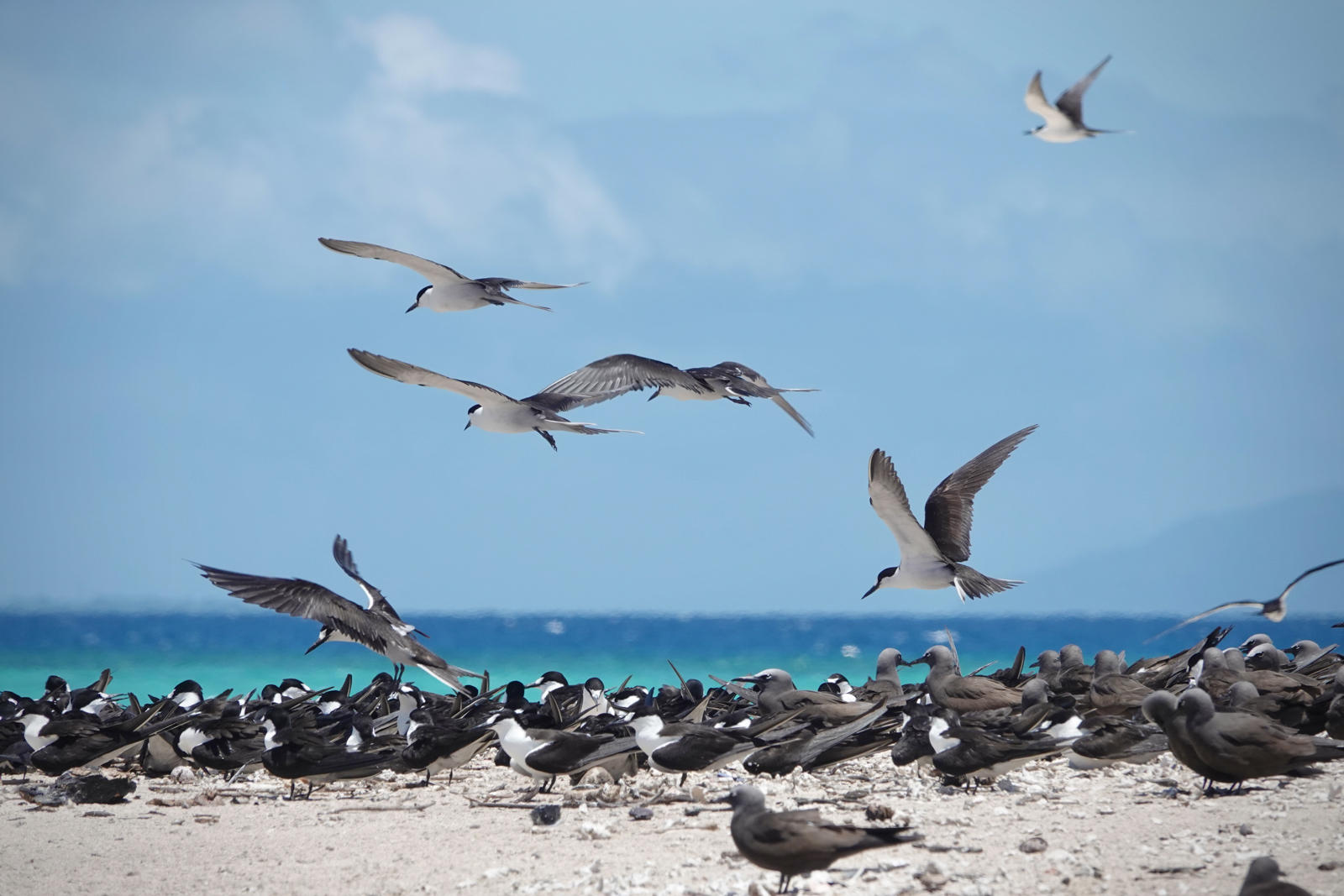
Michaelmas Cay © D Hilaire
Day 4
We started the day with a walk from the hotel to the Northern End of Cairns Esplanade. We had a primary target in mind, and quickly the group all enjoyed brilliant views of a Mangrove Robin about five metres from us on the edge of the thick mangrove forest. Double-eyed Fig Parrots were flying overhead, and soon one landed just in front of us, providing fantastic opportunities for photographs. It was soon joined by a Rainbow Bee-eater, Spangled Drongos and a White-bellied Cuckooshrike.

Double-eyed Fig Parrot © J Mathews
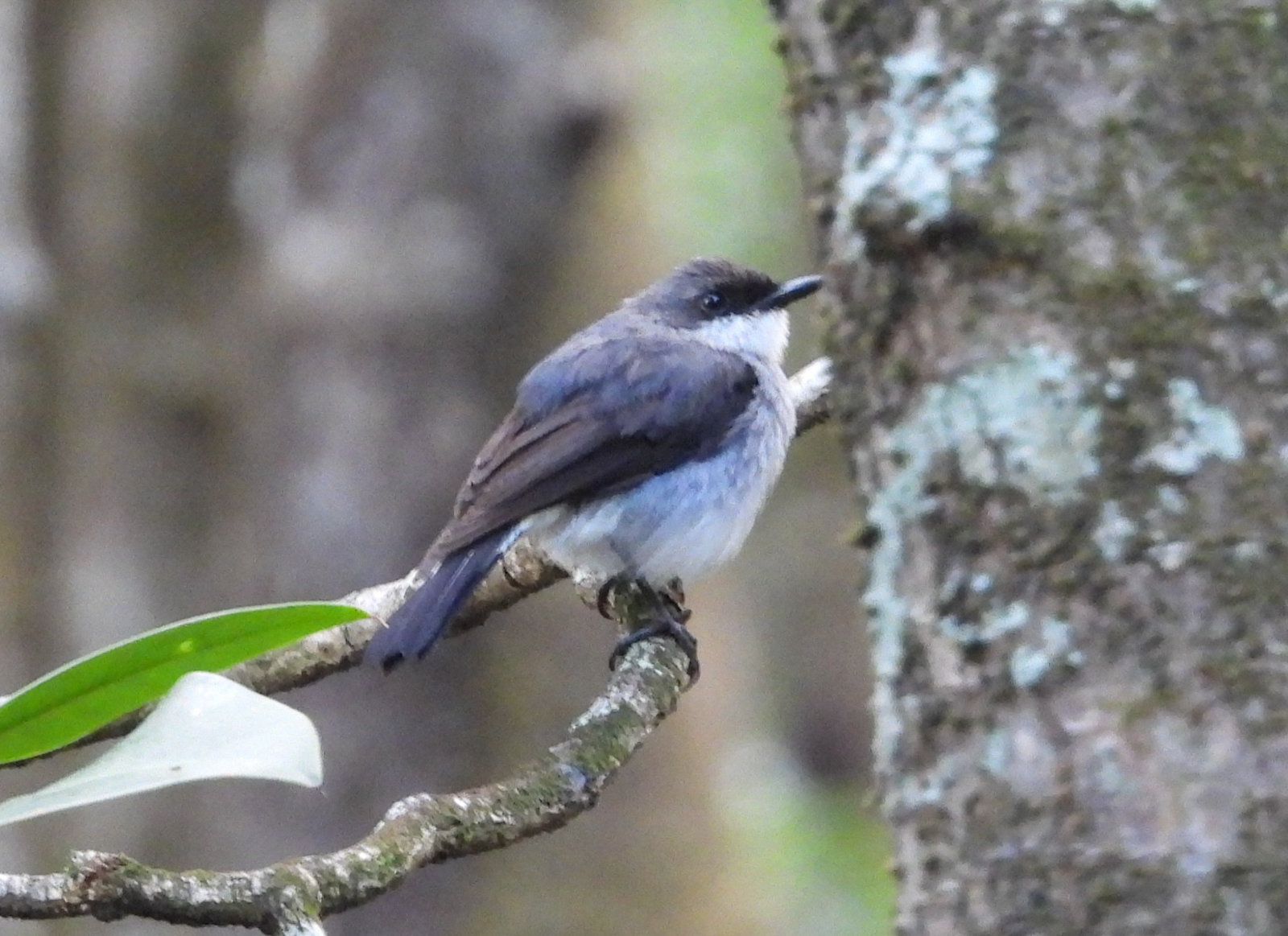
Mangrove Robin © Gregor Tims
After checking out of the hotel, we started our journey north. We visited Yorkeys Lagoon, where we had great views of a very noisy Torresian Kingfisher, two Australasian Darters sunning themselves and more beautiful Crimson Finches. We made a brief stop at Dunne Road Wetlands, where a Marsh Sandpiper was an excellent surprise. We then headed up to Port Douglas, checking in to our motel and enjoying a delicious bakery lunch in town. After lunch, we visited the excellent Ferrero Road Wetlands, where we enjoyed great views of more Comb-crested Jacanas and Green Pygmy Geese, along with exciting new birds for the tour in the form of numerous Radjah Shelduck, Maned Duck and Plumed Whistling Ducks. A Chestnut Teal was a pleasant surprise this far north, but more exciting was a beautiful Little Eagle seen and photographed well heading low over the wetland. A noisy Yellow-spotted Honeyeater eventually revealed itself to the group, before we head to nearby Warri Park Wetlands where guests enjoyed their first views of Australasian Swamphen and Dusky Moorhen along with a nesting pair of Eastern Ospreys.
After a great dinner with stunning views over the water at the Tin Shed, we had an early night ahead of an exciting day.
Day 5
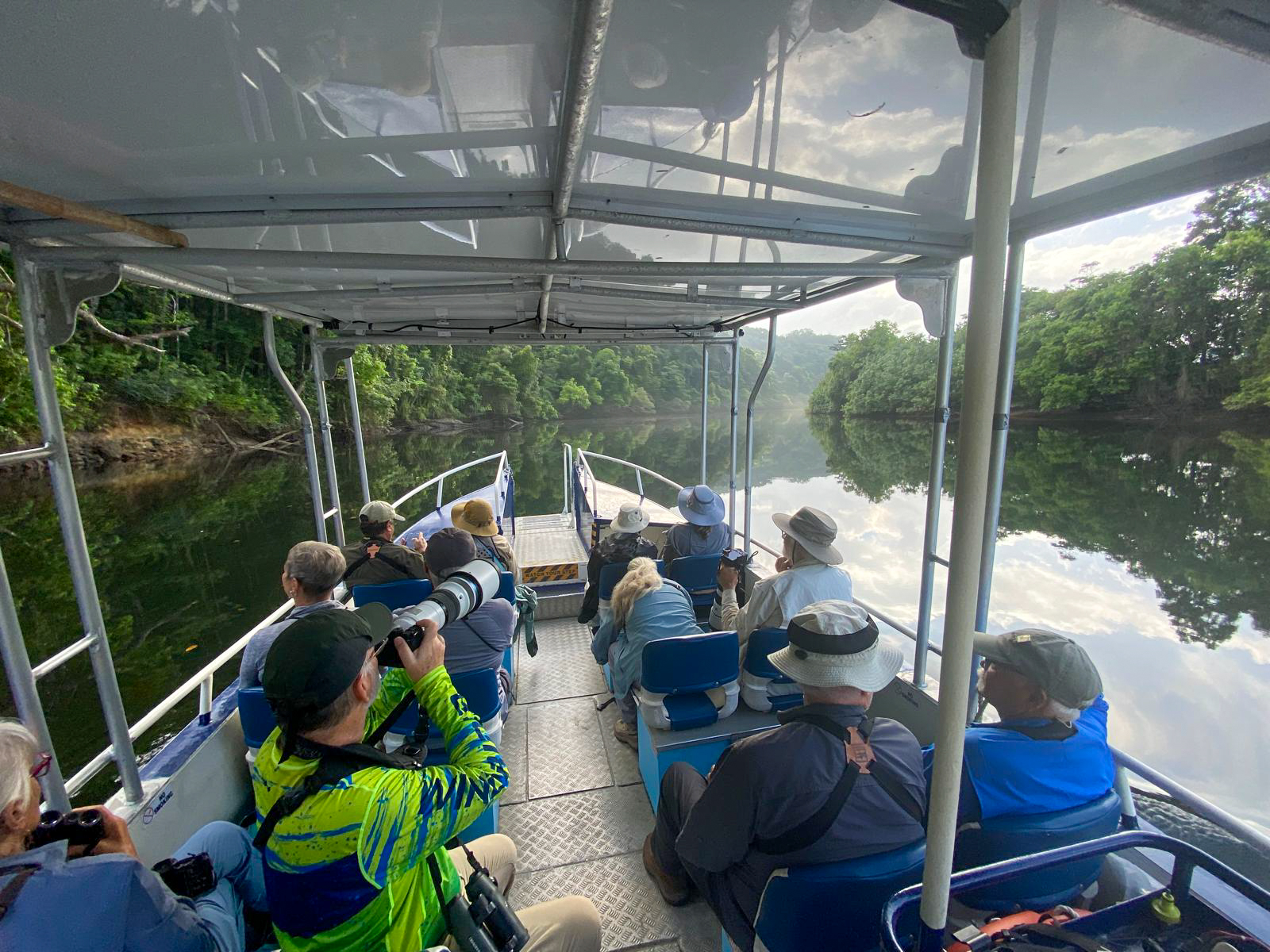
Daintree River Cruise © Gregor Tims
The day began with breakfast at the motel before we embarked on the drive up to Daintree Village for our river cruise. The cruise got off to a great start as a drizzly morning cleared to beautiful sunny skies. Radjah Shelduck joined plentiful Plumed, Great and Little Egrets on the shore, while elusive Striated Herons crept among the mangroves. We were soon treated to fantastic views of Shining Flycatchers nesting on the water’s edge, with guests enjoying exceptional views of both the male and female birds – the male being a stunning satin blue all-over, with the female an eye-catching rusty orange on the back contrasting with a sharp white breast. Another treat awaited us, as an Azure Kingfisher perched close to the boat, allowing for great close-up photographs and wonderful observation of its intricate and striking blue and orange plumage. After enjoying sightings of Pheasant Coucal and Pacific Koel, the skipper had a great surprise in store for us. Pointing towards a small gap in the riverside vegetation, we all enjoyed an incredible view of a Papuan Frogmouth sitting on its nest, its extraordinary camouflage making it difficult to separate this large bird from the branch it had made its home.
Heading further up river, some guests enjoyed a brief view of a Black Bittern, before we had some great excitement in the form of a pair of Spotted Whistling Ducks, a species that first appeared in Australia from New Guinea in 1995 and remains very rare in its restricted North Queensland range. It was a lifer for every guest. On the way back to the wharf, a guest spotted an Estuarine Crocodile resting in shallow water, surrounded by seemingly unaware Royal Spoonbills and Australian Ibises.
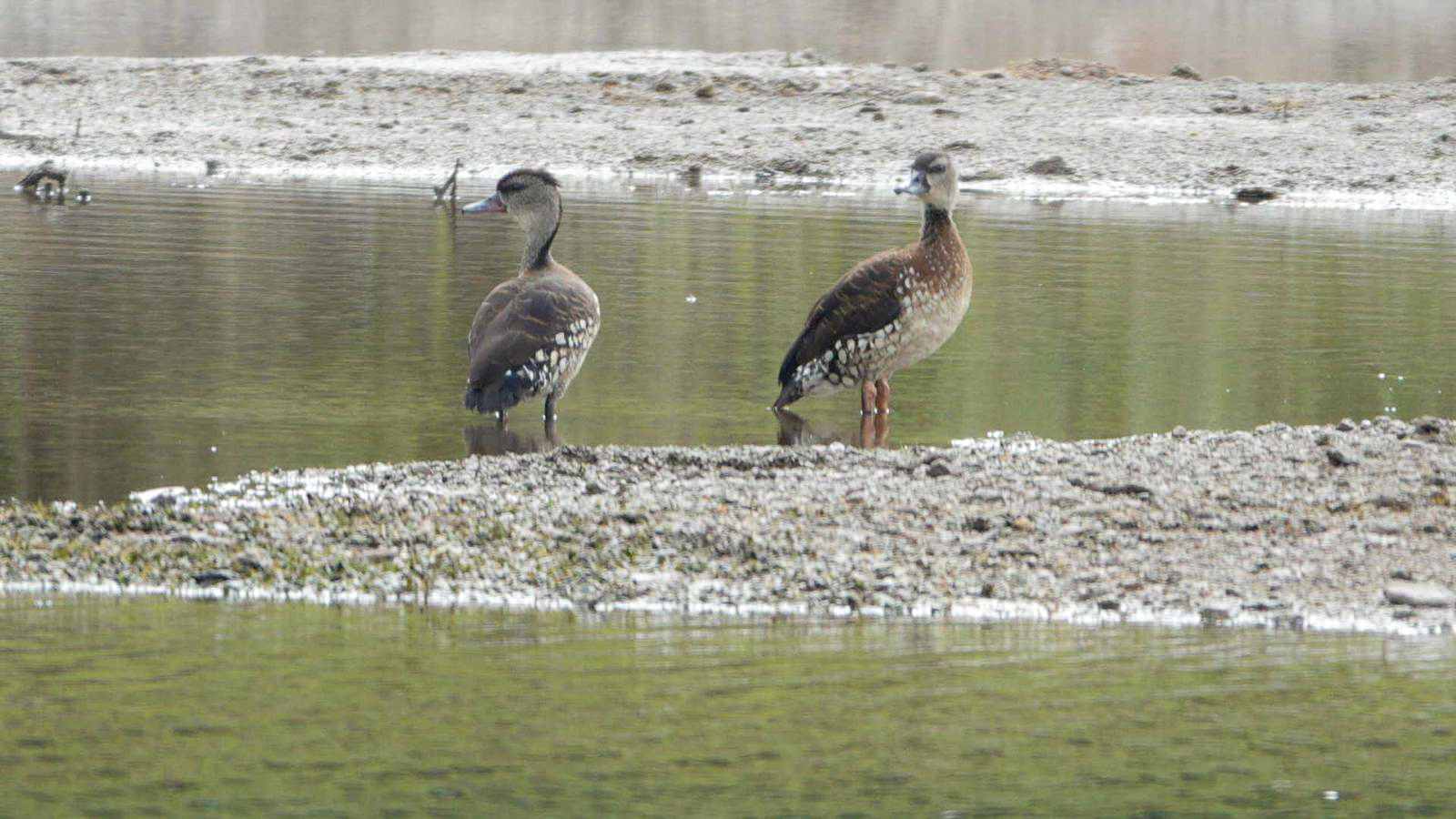
Spotted Whistling-Duck © Jackson Hagley
Some guests were lucky to see a small group of Barred Cuckooshrikes as we enjoyed a quick coffee break in Daintree Village, before we headed inland to Julatten. We started at Sides Road, where a Pacific Baza thrilled guests as it flew low overhead. The eucalypts were alive with songbirds – particularly Honeyeaters, with great views of seven species, including our first Cryptic, Dusky, White-cheeked and Macleay’s Honeyeaters of the trip. It was also lovely to see our first marsupial of the tour – an Agile Wallaby that showed well just next to the road. Forest Kingfishers gave great views as they perched on the electricity wires, while a Brown Cuckoo-Dove went low over our heads. Among the numerous Monarchs and Flycatchers were two beautiful Lemon-bellied Flyrobins while Rufous Shrikethrushes added to the wonderful chorus of bird song. Heading back to the car, we found a large group of funky Topknot Pigeons feeding at the top of fruiting tree.
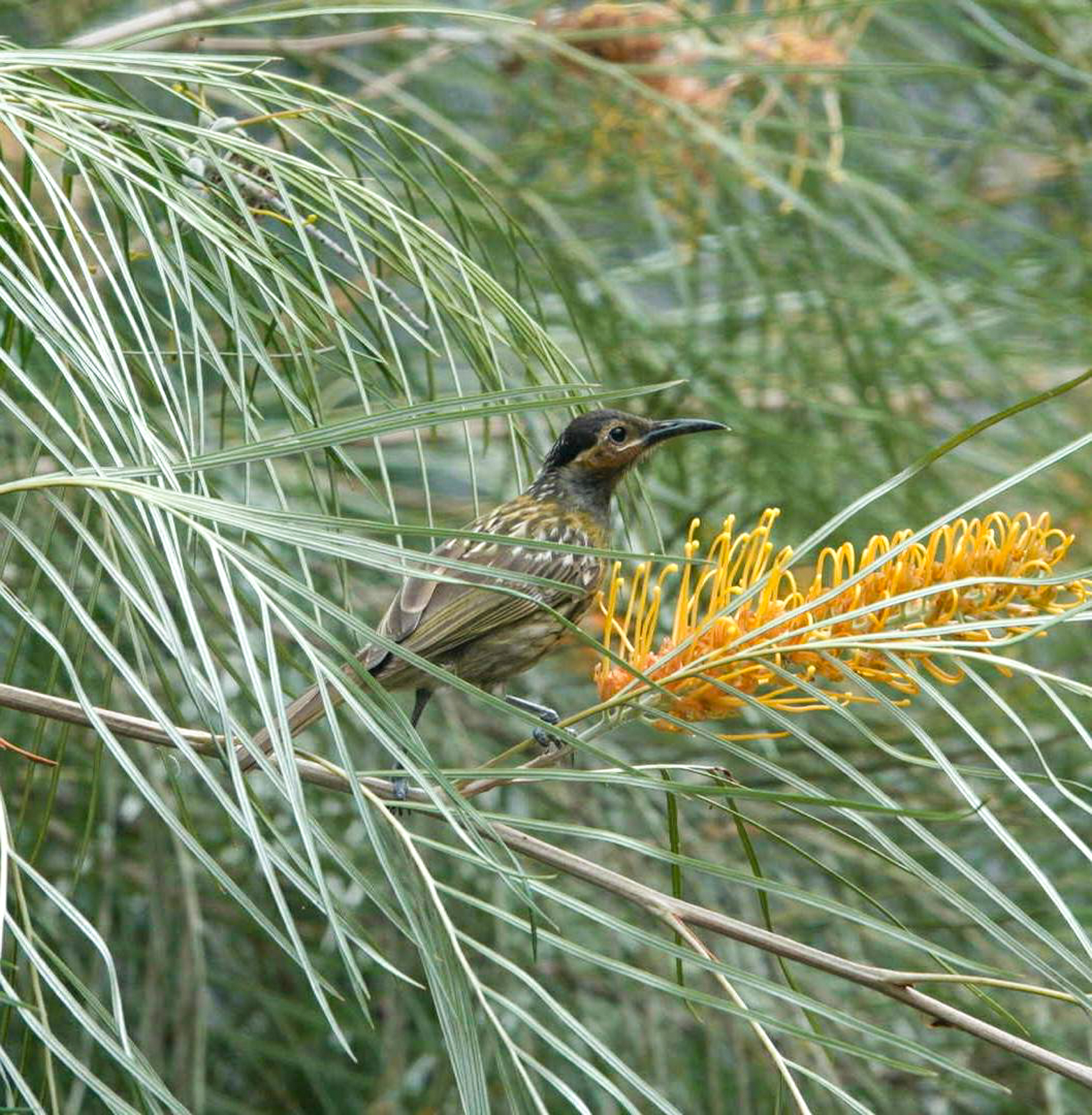
Macleay’s Honeyeater © Jackson Hagley
It was soon time for lunch, which we enjoyed next to a pair of Blue-faced Honeyeaters in Mount Molloy. As we went to turn around our vehicles after lunch, a guest spotted a Great Bowerbird near the police station. A short stroll revealed at least three Great Bowerbird bowers, with several individuals providing excellent views close to the road, while several Red-winged Parrots flashed by, revealing their stunning green and red plumage before we found one perched nearby in a tree.
With inclement weather setting in at Julatten, we decided to head further west out to Mount Carbine. At West Mary Road, we were privileged to find a number of Australian Bustards, Australia’s heaviest flying bird, near the road, including a magnificent displaying male, strutting about parading his magnificent plume of white feathers.

Australian Bustard © Debbie Hilaire
A Brown Falcon soaring low overhead was a wonderful bonus. We continued on to Mount Carbine Caravan Park. This was an exceptionally enjoyable spot for birding and photography, with abundant Pale-headed Rosellas displaying their incredible array of bright feathers, along with further stunning flashes of colour in the form of Galahs and Red-winged Parrots.
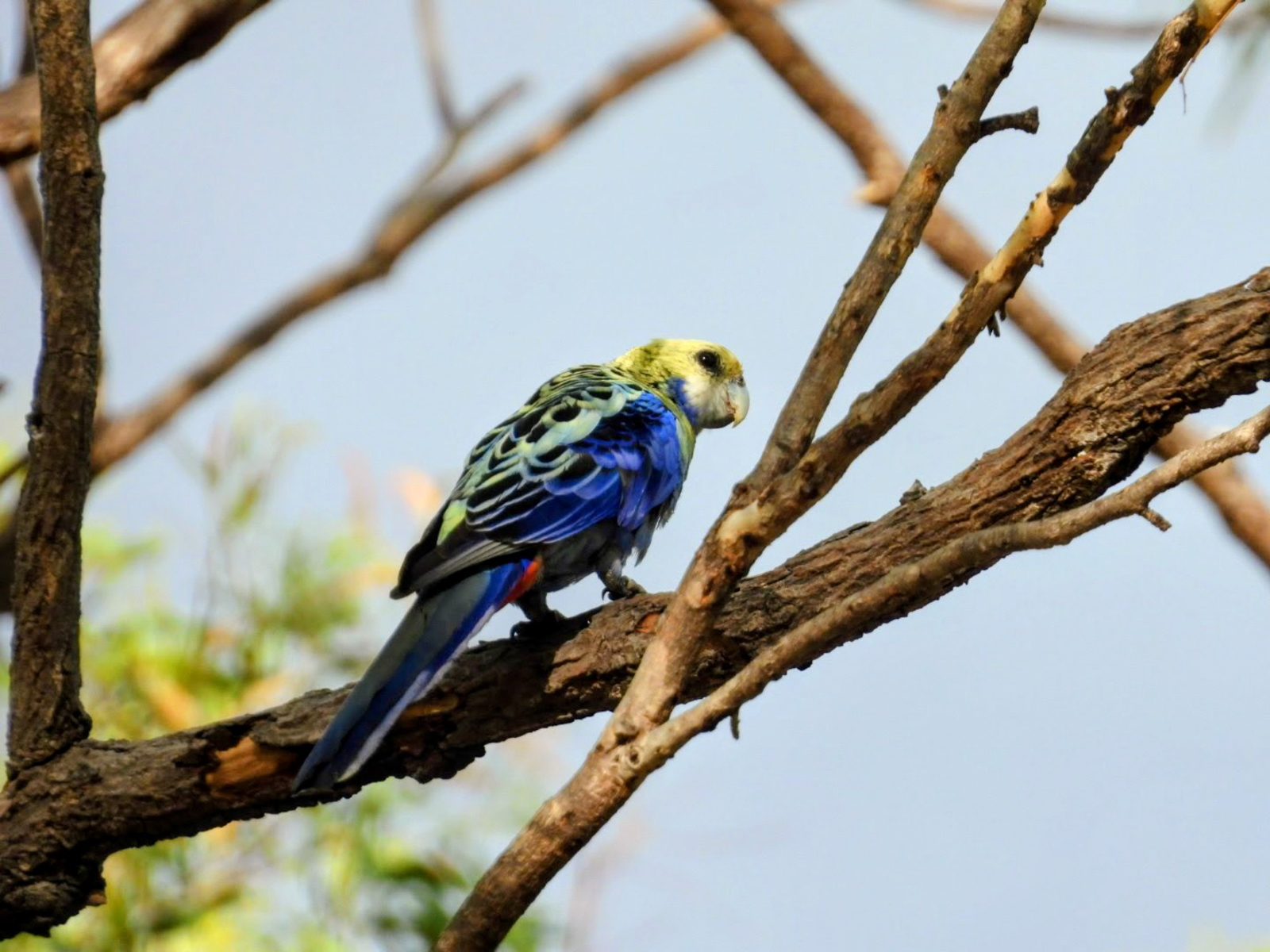
Pale-headed Rosella © S & M Ost
A noisy and boisterous squadron of Apostlebirds soon appeared, giving great views as they came in for a drink, before we were treated to the extraordinary sight of seven Squatter Pigeons together on the campsite lawn. They were joined on the lawn by more Great Bowerbirds, while the trees were alive with Noisy and Little Friarbirds, Black-faced Cuckooshrikes and our first of many Torresian Crows, Australian Magpies and Pied Butcherbirds of the tour. As we enjoyed listening to a raucous group of Blue-winged Kookaburras, we enjoyed one final and utterly wonderful treat for the day – a roosting Tawny Frogmouths spotted just ten metres from us.
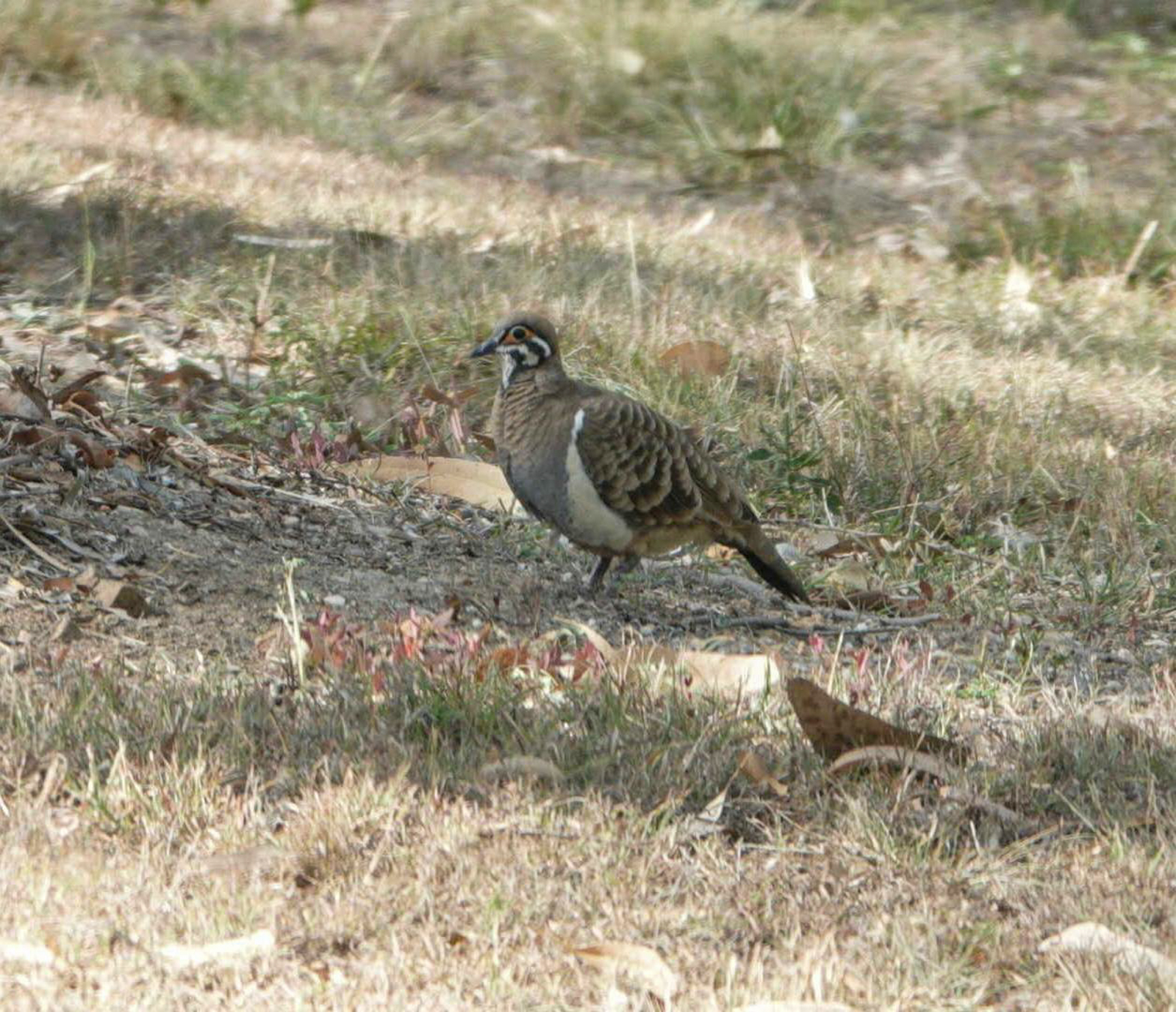
Squatter Pigeon © Jackson Hagley

Tawny Frogmouth © Jackson Hagley
We headed back to Port Douglas for another great waterside dinner, delighted by what had been a varied and exciting day of birding.
Day 6
After another early breakfast, we made our way back to Julatten, starting at Geraghty Park. There, we enjoyed excellent close-up views of a Pale-yellow Robin who seemed intrigued by our presence, while colourful Red-browed Finches and Chestnut-breasted Mannikins brought the roadside vegetation to life. A Grey Whistler eventually revealed itself high in the foliage, while plentiful Honeyeaters, Monarchs and Shirkethrushes entertained the guests. We enjoyed the raucous chattering of a large Metallic Starling colony, but the highlight came as we approached our vehicles, with a guest spotting a stunning Green Ringtail Possum, a rare and isolated endemic to high-altitude tropical Queensland forest, just next to the path, carrying its baby on its back. It was a real privilege to watch this magnificent species so close in daylight.
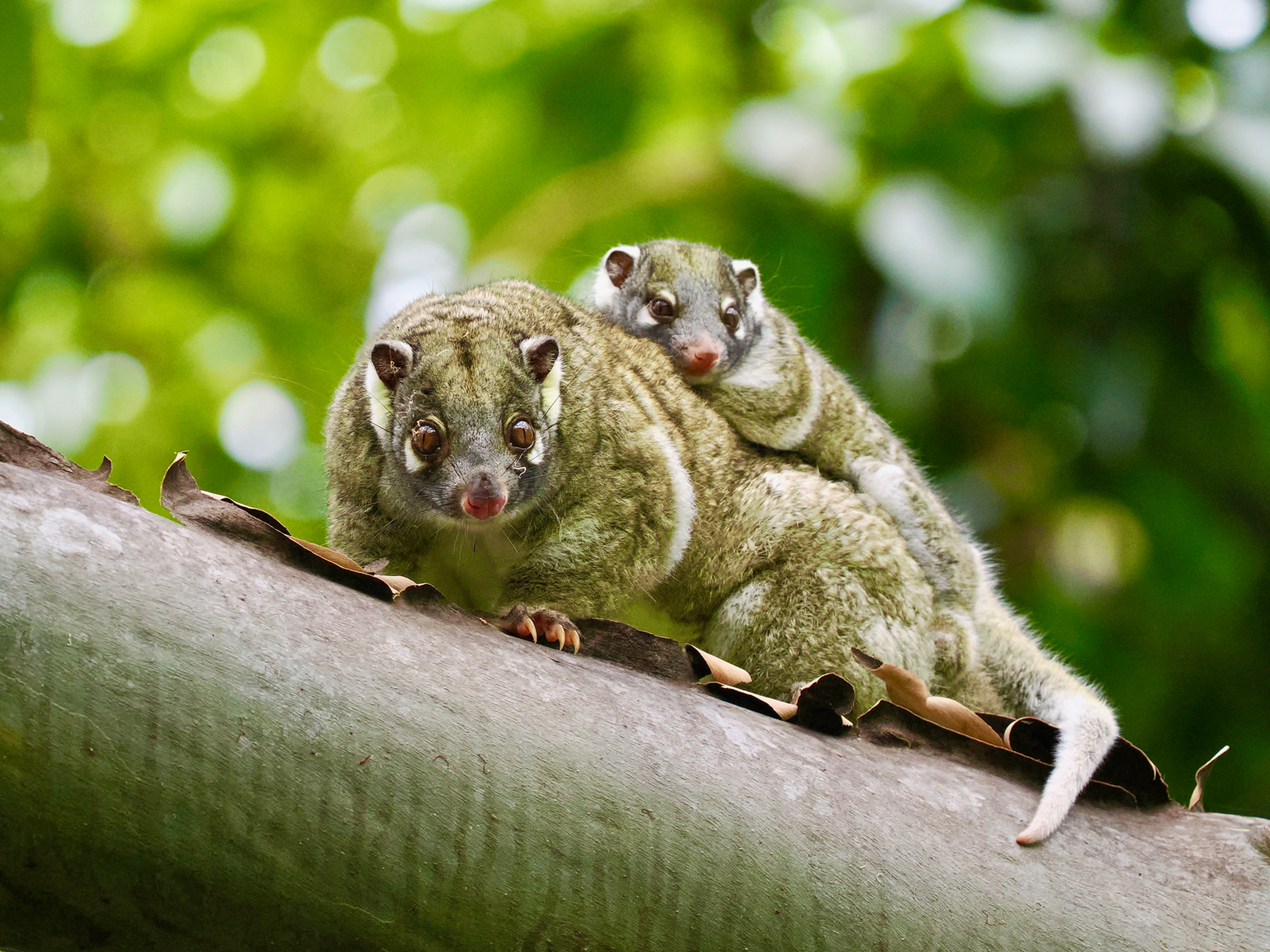
Green Ringtail Possum © J Mathews
We then headed to Abbattoir Swamp. We could immediately hear abundant bird song in the carpark and soon a group of appropriately-named Lovely Fairywrens revealed themselves. We enjoyed exceptional views as they flitted about the dry vegetation. Heading down to the swamp, we came across their equally stunning close-relative – a magnificent male Red-backed Fairywren showing of his extraordinary contrasting black and red plumage near the path. A vocal Rufous Whistler was a great bonus, while a resplendent Wedge-tailed Eagle dwarfed the neighbouring Black and Whistling Kites over the swamp.
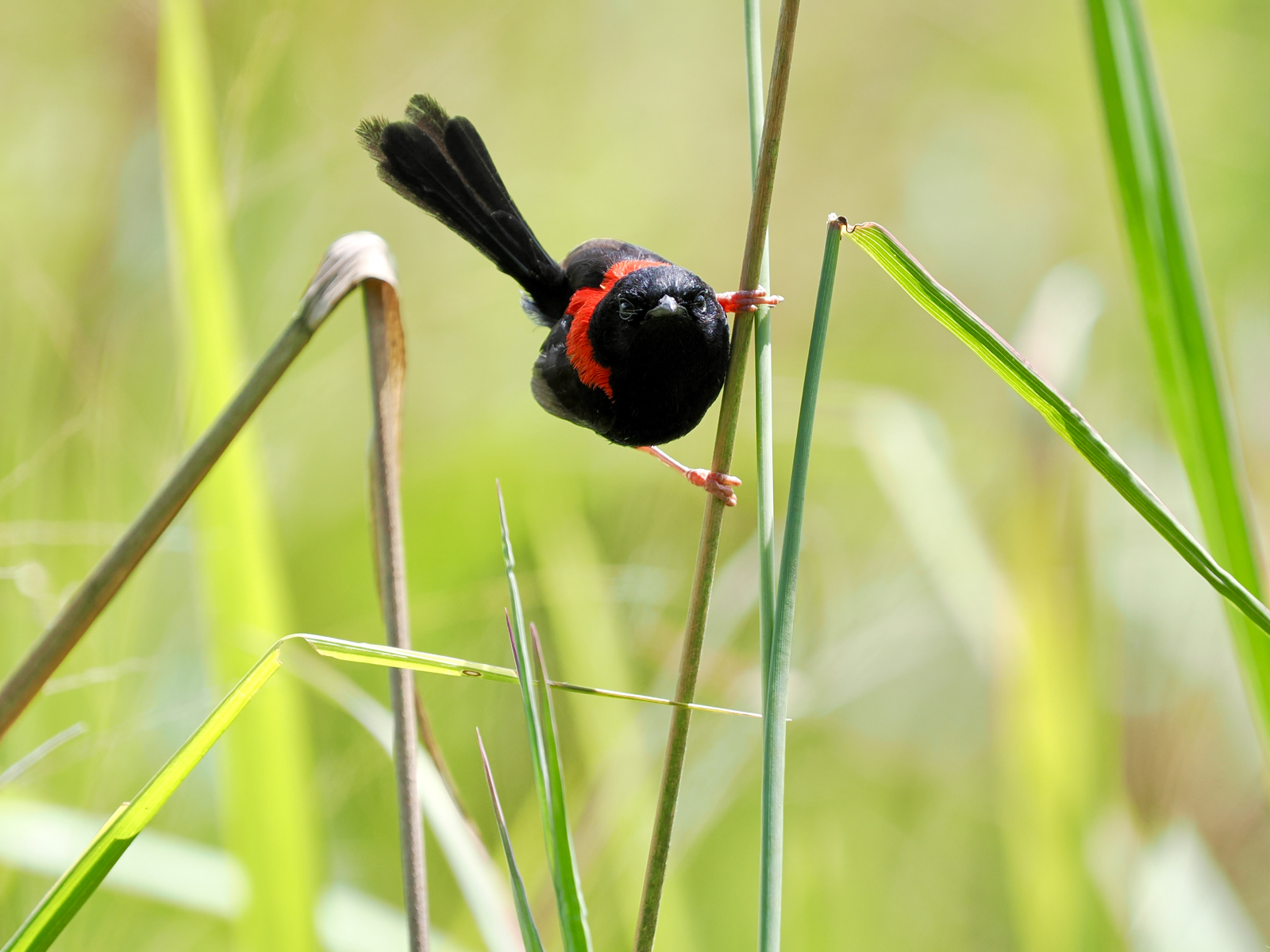
Red-backed Fairywren © J Mathews
Heading south, some guests enjoyed brief views of a Brown Quail flying over the road, while a Blue-winged Kookaburra was perched on the power lines.
We made stops on the way to Mareeba, adding some dry forest birds to the tour total, including the wonderfully sonorous Olive-backed Oriole. We sadly missed the White-browed Robin on a hot afternoon while we enjoyed a delicious lunch in a park in Mareeba, but we would return. We continued our journey south, arriving at the superb Chambers Rainforest Lodge in the late afternoon.
After checking into the hotel, we enjoyed a short walk in its surrounds, delighting in great views of a Grey-headed Robin who appeared as fascinated by us as we were by it. Barred Cuckooshrikes, Large-billed Scrubwrens and Bower’s Shrikethrushes made for an exciting introduction to Tablelands birding, while a resplendent Australian Golden Whistler showed off his striking plumage and song, and several Victoria’s Riflebirds provided several guests with an exciting birding landmark – their first Bird of Paradise.
With dusk soon approaching, we journeyed to Yungaburra with a special mammalian target in mind. Watching from the viewing platform, we were excited to spot the ripples of a creature moving underwater. Getting our binoculars onto it, we had a complex combination of both excitement and (minor) disappointment as it revealed itself to be a Rakali, an underrated native Australian water rat whose warm fur led to its near-extinction in the early days of European settlement. Soon after, we had another increase in heart rate as more ripples appeared. Inspecting the ripples, we were overjoyed to see the unmistakable beak of a Platypus, actively making its way downstream, using electrical charges from its bill to find and feed on small water creatures. We headed to dinner after what had been another great day, enjoying a wholesome feast at the Yungaburra Hotel while hundreds of Spectacled Flying Foxes passed overhead.
But the day was not yet done. Heading back to Chambers, both vehicles were treated to views of Northern Brown Bandicoots and the distinct Tablelands race of Brushtail Possum on the road. Returning to the lodge, we headed down to their feeding station where Sugar Glider and Striped Possum put on a great show just metres from us, against a backdrop of calling Southern Boobooks and Red-necked Crakes.
Day 7
After enjoying a great breakfast, we started our day at high-altitude Mount Hypipamee. The carpark was alive with birds, with three species of Scrubwren, including the endemic Atherton Scrubwren, a very friendly Pale-yellow Robin and several Honeyeaters, including another Tablelands endemic in the form of Bridled Honeyeater.

Pale-yellow Robin © J Mathews
We soon spotted the unmistakable deep purple breast of a Wompoo Fruit-Dove, which eventually turned to reveal its beautiful mosaic of green, yellow and grey hues to its back. Heading up the road from the carpark, we spotted a large black presence near the path. We quickly realised that we were in the presence of one of Australia’s most extraordinary creatures – a Southern Cassowary, with a male bird feeding just next to its (large) chick. It felt surreal to watch these prehistoric and remarkably colourful enormous birds from close range. A handful of metres further up the road, our luck continued as Golden Bowerbirds appeared. Though we had only brief views of the exquisite bright colouring of the male as it moved quickly through the forest, several females showed well for us and we were able to appreciate their subtle but intricate brown-yellow plumage.
We then headed up to the gorge, where we enjoyed great views of the distinct northern race of Crimson Rosella, along with Scarlet Honeyeaters and a surprise Black-shouldered Kite overhead. We eventually found a Mountain Thornbill on our way back to the vehicles.
Our next stop was Malanda for lunch, though one vehicle enjoyed the magnificent sight of a pair of Sarus Cranes flying low over the road.
Unfortunately a tropical thunderstorm set in, and we were forced to take shelter immediately after arriving at Lake Barrine. While avoiding the heavy downpour, we enjoyed watching dozens of Great Crested Grebes on the lake.
With a brief break in the rain, we made our way down to the track through the rainforest bordering the lake. We were soon delighted to find a small group of Chowchillas feeding on the path, offering exceptional views for all the guests. Sadly, with nearby thunder and darkening skies, we made the decision to return to the vehicles and then headed back to the lodge as heavy rain returned.
After a weather-induced break, we headed back out, driving to farmland near Yungaburra. There, we enjoyed brilliant views of three Sarus Cranes feeding near the road, while a stunning white-morph Grey Goshawk perched on nearby power lines was an exceptional bonus.
We continued to Curtain Fig Tree just before dusk, taking a delightful walk on the boardwalk around this magnificent and ancient strangler fig. After dusk, we waited by a hole that was once home to a Lesser Sooty Owl. We caught vision of movement in the hole, turning on our torches as the creature emerged. We were not expecting it to be a Brushtail Possum! We decided to walk around the boardwalk again before we left, and how fortuitous it was that we did so. The unmistakeable screech of a Lesser Sooty Owl soon revealed itself at almost eye-level, just metres from the group. It was one of the highlights of the trip to watch this stunning bird from close range.

Curtain Fig © Gregor Tims
We soon left the bird in peace, returning to Yungaburra Hotel for another great dinner. Some of us went searching for nocturnal birds at nearby Yungaburra Cemetery after dinner, sadly drawing blank on birds, but enjoying phenomenal mammal watching in the form of abundant Agile Wallabies, Red-legged Pademelons, Long-nosed Bandicoots and a wonderful Green Ringtail Possum. We also had great views of a large Scrub Python on the road. Other guests enjoyed the Chambers feeding station, where they too were treated to a Long-nosed Bandicoot, Pademelons, Striped Possum and Sugar Glider.
Day 8
We began the day with a walk around Chambers Rainforest Lodges. A White-headed Pigeon and Pacific Baza made for a great start near reception, before we came across a great array of Tablelands specialities in the forest. This included Yellow-breasted Boatbills, raucous Spotted Catbirds and a wonderful treat in the form of a Pied Monarch just above our heads. Numerous calling Superb Fruit Doves brought the forest to life, as did a rasping male Victoria’s Riflebird.
After breakfast, we checked out of the hotel and headed back to Lake Barrine. We had one primary target there, and quickly found it – a loud Tooth-billed Bowerbird proudly belting out an impressive array of mimicry just metres from his bower. We continued to Lake Eacham, enjoying stunning views over the beautiful crater lake, and soon came upon more Yellow-breasted Boatbills and our first Fairy Gerygone of the trip.
Our next stop was the wonderfully vibrant Hasties Swamp, which abounded in an abundance of waterbirds. New species for the trip seemed to be everywhere, with Wandering Whistling Ducks, Grey Teal and Hardhead on the lake, beautiful Pied Stilts strutting about the shoreline and a Pacific Heron distantly feeding in the shallows. Behind the wetland, we found a Dollarbird perched on a farm fence, while roosting Nankeen Night Herons next to the hide delighted us all. A friendly Eastern Yellow Robin performed for the whole group, while on the way out we had a fantastic surprise as we picked out a Latham’s Snipe creeping across the muddy shore.
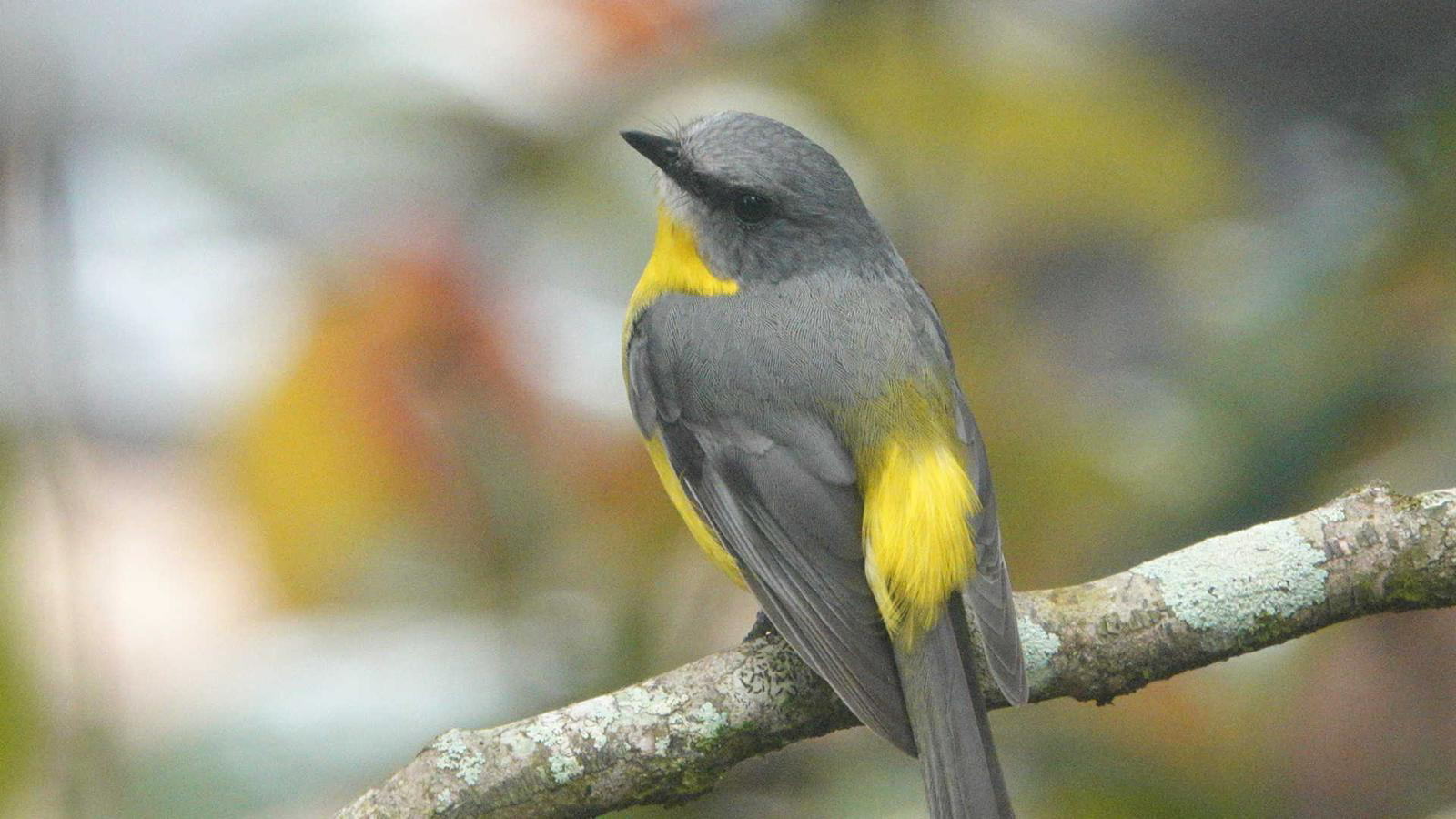
Eastern Yellow Robin © Jackson Hagley
We returned to Mareeba for lunch, this time trying a new roadside spot for White-browed Robin. This time we had more luck, as this striking species appeared almost immediately, belting out its melodious song and showing exceptionally well.
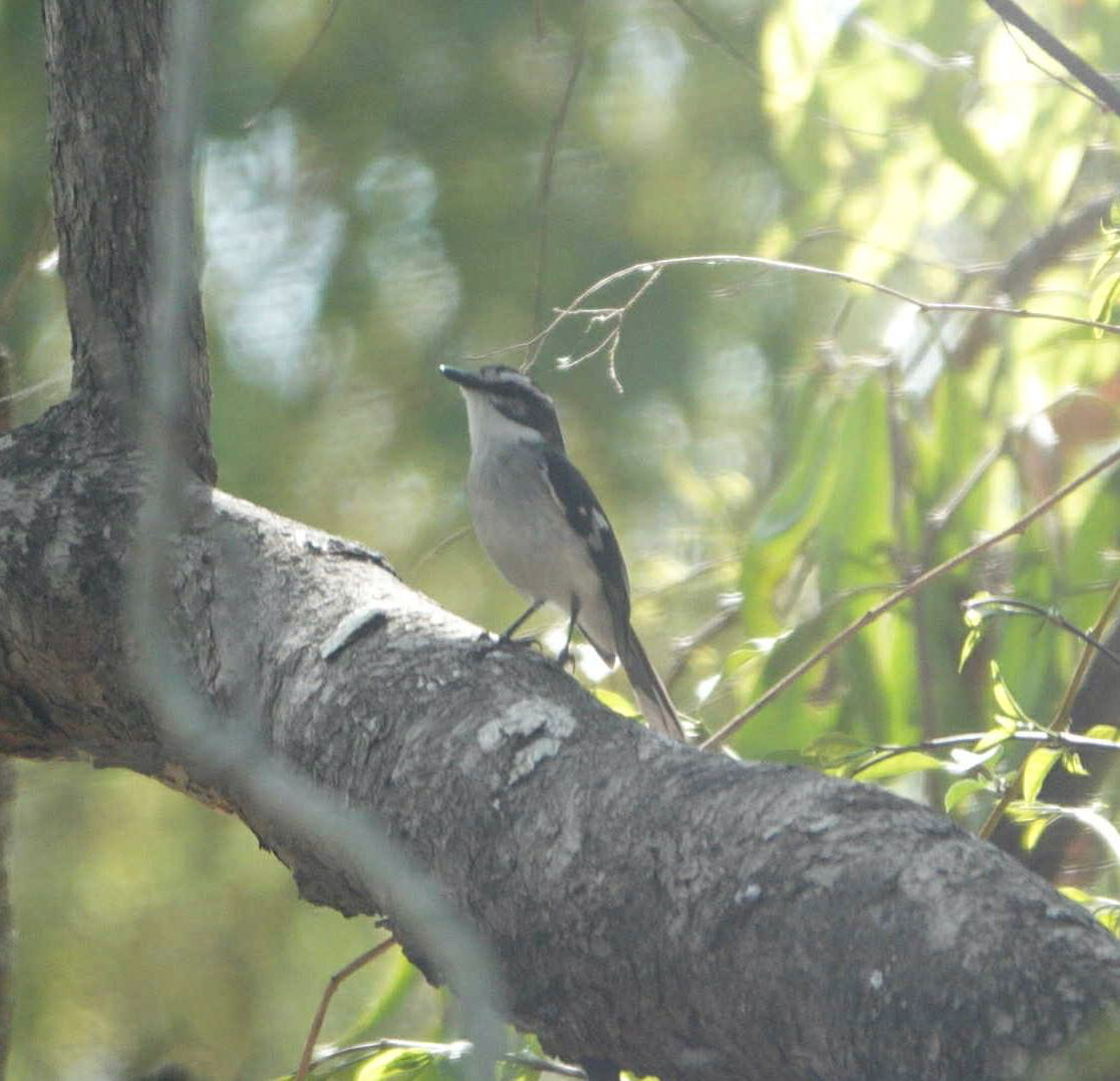
White-browed Robin © Jackson Hagley
We continued back to Cairns, returning to the Bay Village Retreat for a single night and a delicious dinner.
Day 9
We started the day with an early-morning walk at the Esplanade, where we found roosting Little Flying Foxes. It was soon time to head to the airport for our flight down to Brisbane.
After a delightful lunch near the airport, we moved to Tabbil-ban dhagun Boardwalk at Nudgee Beach. We quickly picked up our two targets there – Mangrove Honeyeater and Mangrove Gerygone, with an individual of the latter seen feeding a large and demanding nest-parasitising Shining Bronze Cuckoo chick. Two shrieking Channel-billed Cuckoos overhead were a great bonus, alongside a supporting cast of shorebirds, and we soon began our journey south to Lamington National Park.
Wallabies were abundant as we began our drive up through the National Park, with both Red-necked and Pretty-faced showing well by the roadside. We arrived at O’Reilly’s at dusk, in time for a wonderful dinner and an early night after a long day of travelling.
Day 10
We started the day with a walk along the Rainforest Track near our accommodation. Before we had even entered the forest, the guests were thrilled by a smorgasbord of colour, noise and attitude in the form of Australian King Parrots, Regent and Satin Bowerbirds and Crimson Rosellas – with some even landing on us!
The track was ringing with bird song, with Green Catbirds, Lewis’s Honeyeaters, Eastern Whipbirds, Eastern Yellow Robins and abundant Scrubwrens and Gerygones calling from every direction. Australian Logrunners crept about the understory, while a Noisy Pitta gave us an extraordinary view from just beside the track. Several beautiful Rufous Fantails appeared, one bringing particular joy as it followed us along the path flitting from branch-to-branch. Just as we returned to the lodge, we caught sight of a pair of Thrushes creeping about the undergrowth. We were able to enjoy close views, confirming their identity as the range-restricted Russet-tailed.
After breakfast, we explored several other tracks within Lamington, with the highlight being great views of a singing Rose Robin, its striking pink breast being especially eye-catching in the dark forest. Other notable sightings included a Brown Goshawk, Eastern Spinebills and White-naped Honeyeaters.
After a picnic lunch, we returned to O’Reilly’s where guests enjoyed the wonderful experience of feeding the abundant Satin and Regent Bowerbirds, King Parrots and Crimson Rosellas by hand. Opportunistic Red-browed Finches added to the cacophony of colour and sounds as they picked up spilt seeds.
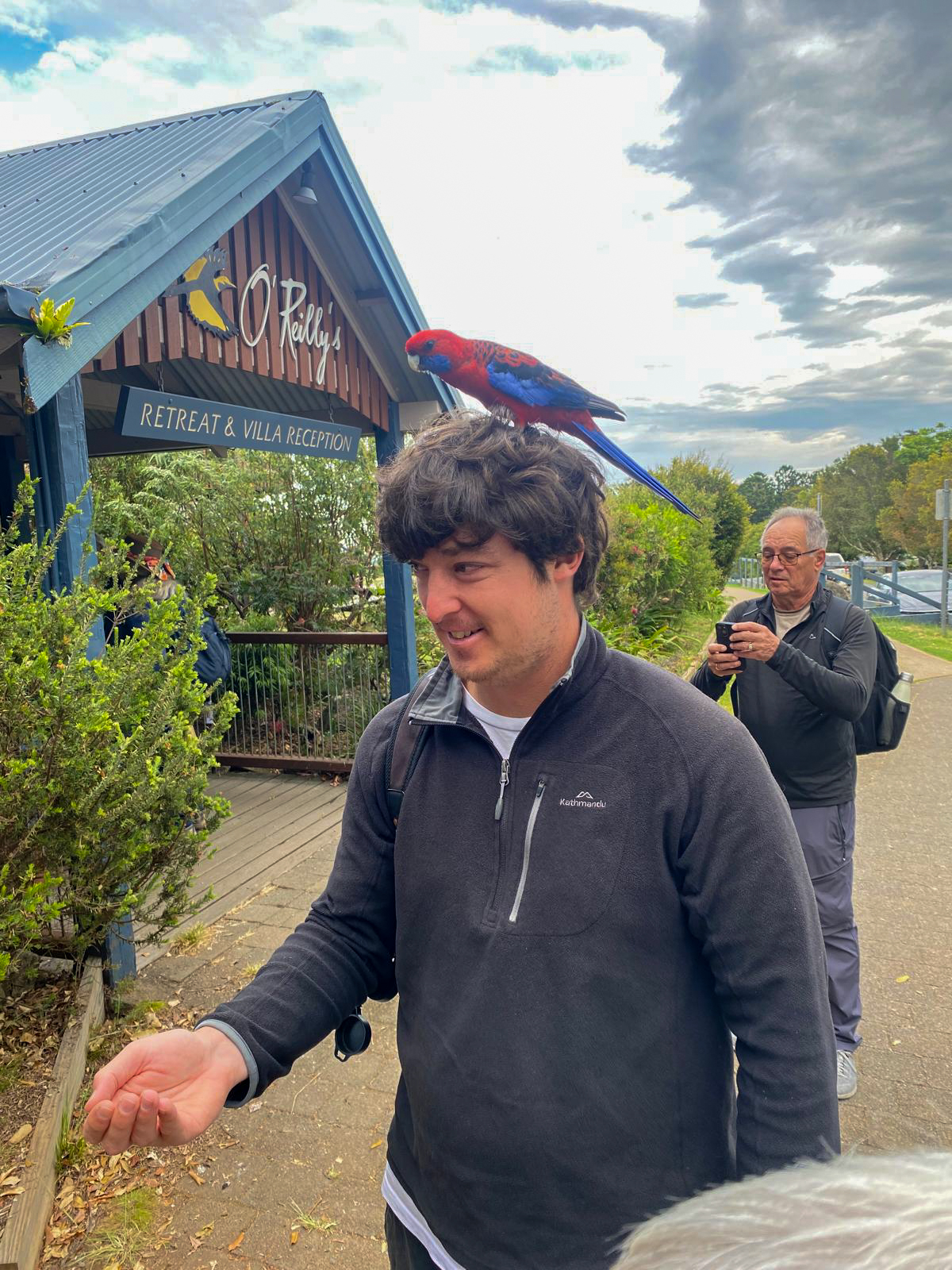
Guide Jackson Hagley gets to know one of the locals (Crimson Rosella) © Gregor Tims
Before dinner, we enjoyed a walk down the Wishing Tree Track, where the highlight was a pair of male Rose Robins duelling mid-air while a female watched on. Some of the group continued around the carpark and were treated to great views of a Bassian Thrush foraging in the leaf litter.
After another great dinner, we did a night walk down the Wishing Tree Track. It was a noisy night, with Greater Sooty Owls, Boobooks and Australian Owlet-Nightjars calling. Catching two sets of eyes in the torch light, we were pleased to see the unique Lamington-race of Ringtail Possum. But the highlight was to come – after a patient wait, a magnificent Marbled Frogmouth appeared just above our head calling loudly, completing the delightful trio of Australian Frogmouth species for our trip. Red-necked Pademelons near the hotel were another wonderful addition to our trip’s mammal total.
Day 11
We started with an early-morning walk along the rainforest track. Just as we started to head back to the hotel, we had a frustratingly brief view of an Albert’s Lyrebird sprinting across the forest floor. We checked out of O’Reilly’s and began the journey back to Brisbane. Those lucky enough to be in the front vehicle had a moment of great fortune as an Albert’s Lyrebird zoomed across the road in front of them. Sadly we were unable to relocate the bird after pulling over.
We boarded our flight to Brisbane and flew to Sydney. We checked into our hotel in the early afternoon and then went for a quick walk around the nearby Landing Lights Wetland to introduce the guests to the birds found around Sydney. We enjoyed great views of Red Wattlebirds, New Holland Honeyeaters, Superb Fairywrens and Yellow Thornbills in the surrounding bushland, while Chestnut Teal and Pied Stilt were especially abundant on the swamp. It was with mixed emotions that we observed numerous Red-whiskered Bulbuls around the reserve, enjoying their striking plumage while acknowledging their detrimental impact on native bird populations.
We had a lovely dinner a short walk from the hotel.
Day 12
We started the day by heading south to Royal National Park, just south of Sydney. We started at Fig Tree Flat, which was alive with birds, including Green Catbird, Satin Bowerbird, Maned Duck and ducklings, Crimson Rosellas and King Parrots. We soon had another lifer for much of the group, as a noisy squadron of Little Friarbirds appeared all around us, followed by a magnificent view of a male Variegated Fairywren moving quickly through vegetation near the path. Heading further down the path, we were excited to hear the unmistakably pitch-perfect musical performance of a Superb Lyrebird, serenading the group with an exquisite array of mimicry, with a particular penchant for the Pied Currawong. While we were enthralled by the performance, the bird was proving elusive, despite being just a handful of metres from us. We waited patiently, and were eventually rewarded with one of the moments of the trip, as the Lyrebird casually strolled right across the path in front of us.
Utterly filled with joy, we returned to the carpark, where the unmistakable buzzing of a Sahul Cicadabird welcome us back to our vehicles. It eventually showed itself for the whole group. Just as we climbed into the cars, we heard a special little bird belt out its mournful whistle. With some more patience, it eventually appeared low over our heads. A beautiful and charming Spotted Pardalote, posing perfectly for photos.
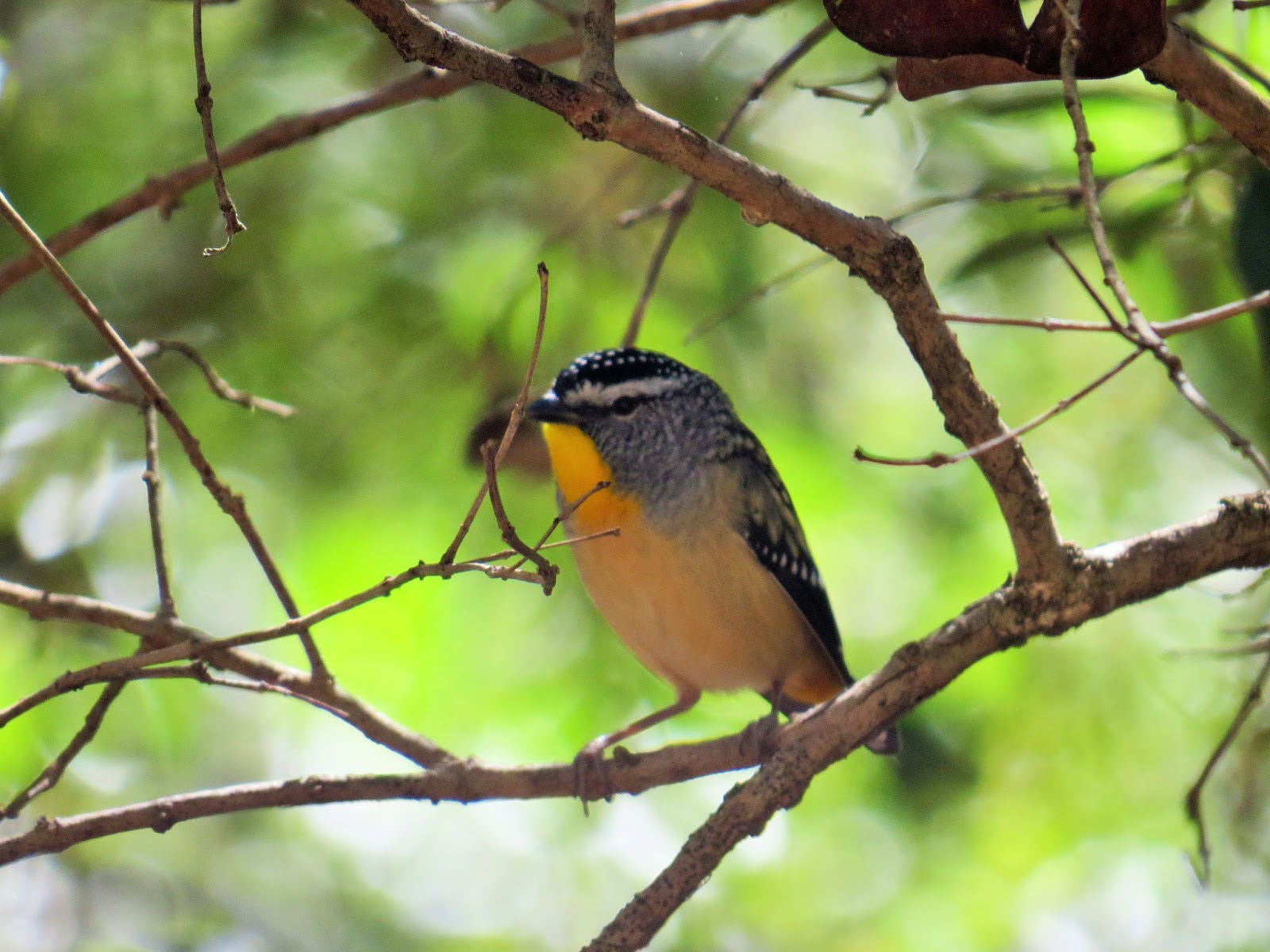
Spotted Pardalote © Gregor Tims
Our next stop was Wattamolla Beach. We were delighted to have a noisy group of Yellow-tailed Black Cockatoos drift languidly overhead by the carpark, before we continued to the lookout point. There, we were treated to the awe-inspiring sight of several Humpback Whales playing together just metres offshore. Sadly, on a beautiful and sunny Sunday so close to Sydney, Wattamolla became busy and as such, birdlife proved tricky to locate. We enjoyed a magnificent Tree Goanna near the carpark, before heading back towards Sydney.
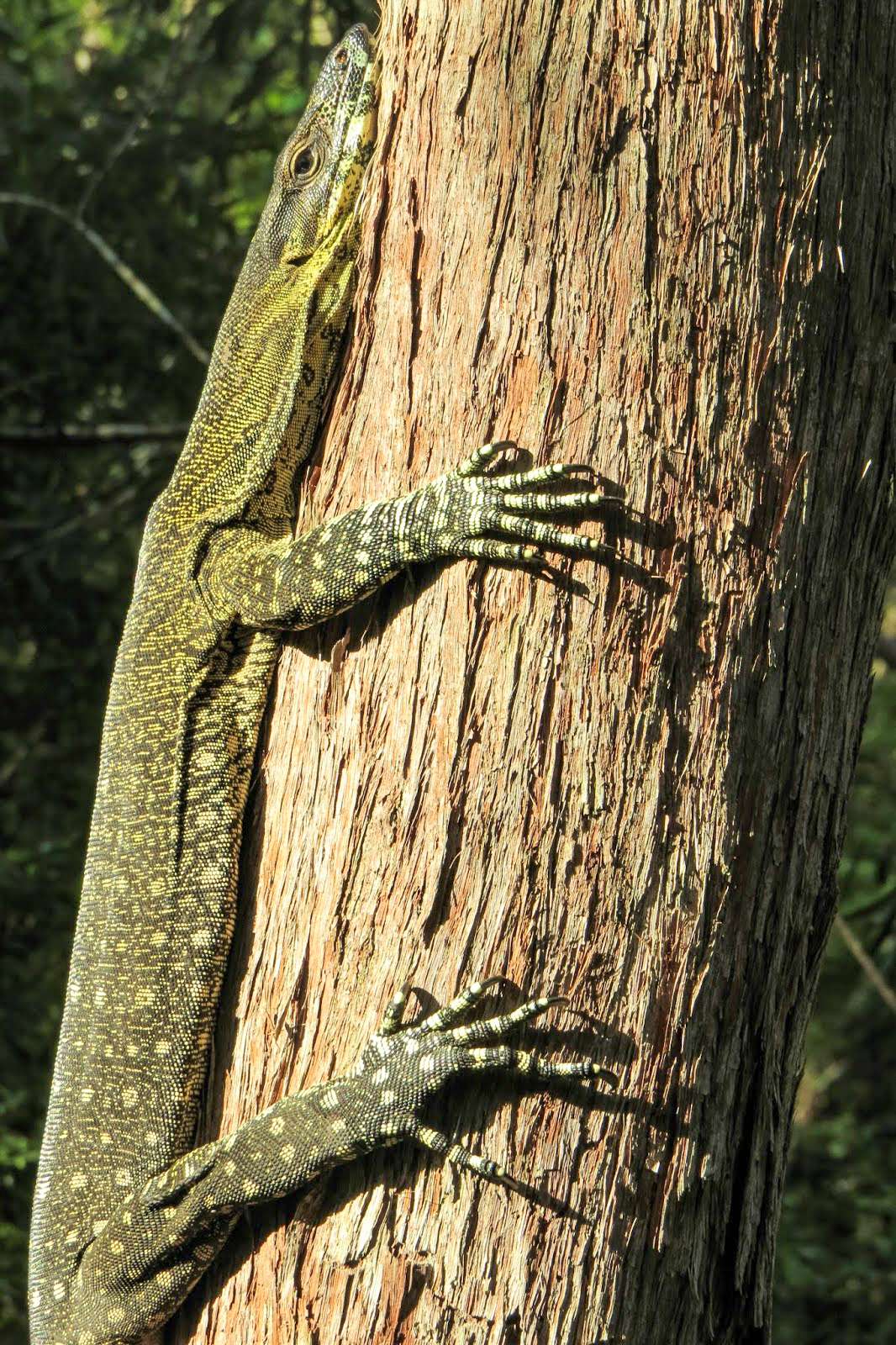
Tree Goanna © Gregor Tims
After lunch at a bakery in South Sydney, we pushed through the traffic to the Royal Botanical Gardens in the centre city. There, guests enjoyed wonderful views of the Sydney Opera House over the water. We had one bird target in mind, and made our way to a beautiful large fig tree in the gardens. We found pellets and white wash, but heartbreakingly there was no sign of the tree’s famous inhabitant – a Powerful Owl. We spent time searching the neighbouring trees but to no avail – though we did have a moment of great excitement as a procession of Pied Currawongs and Noisy Miners joined in mobbing a large bird in the top of a tree. It hopped out into the open and revealed itself to be a Channel-billed Cuckoo, giving unusually close views of this beast of a bird.
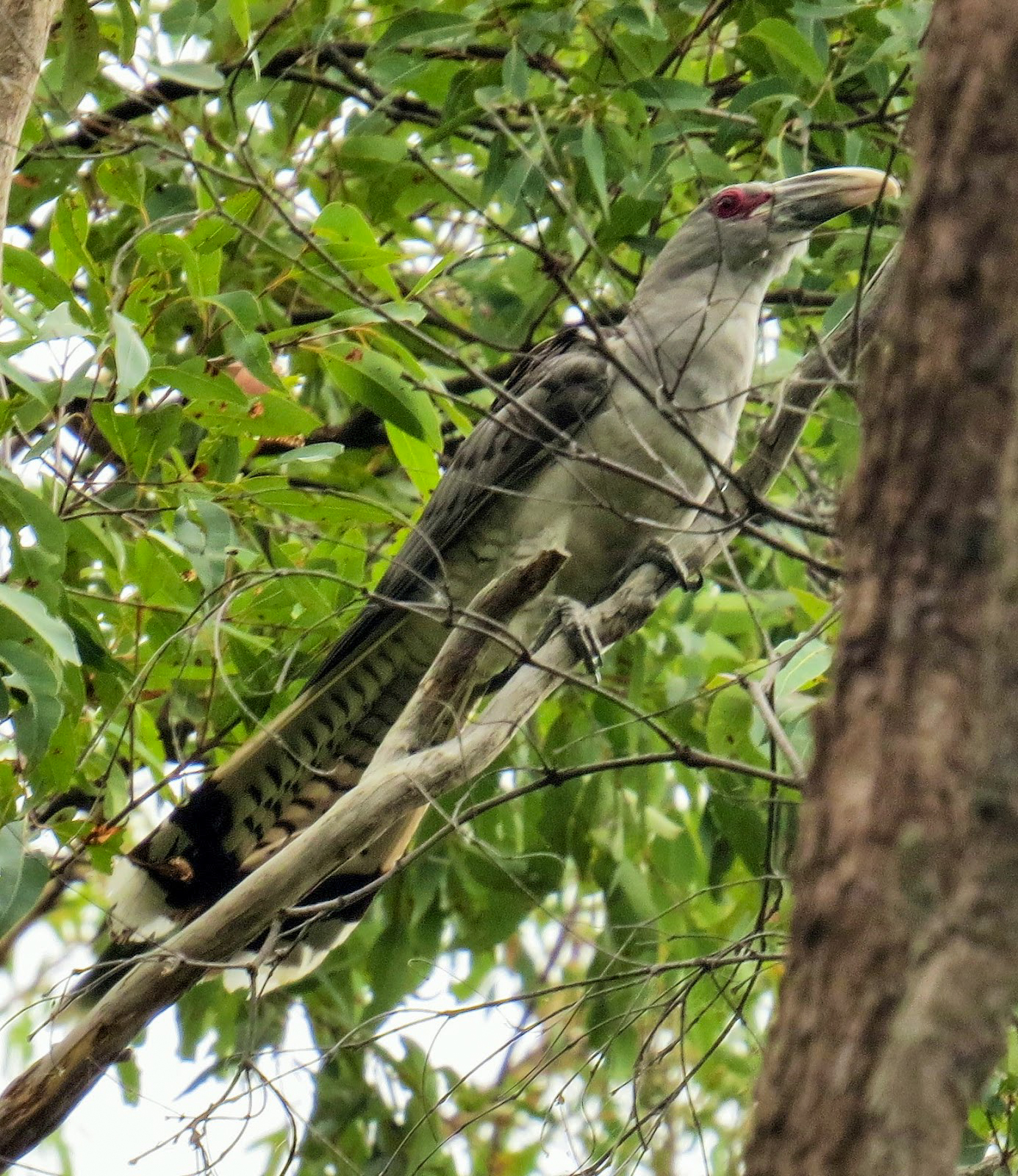
Channel-billed Cuckoo © Gregor Tims
Our next stop was Centennial Parklands. We enjoyed great views of abundant waterbirds on its main lake, including Australian Pelicans, Grey Teal and Hardhead, and quickly found our main birding target – five Black Swans, who afforded us wonderful photo opportunities. We made our way round to Lachlan Swamp, where we delighted in close-range views of the swamp’s thousands of roosting Grey-headed Flying Foxes, picking out a handful of Black Flying Foxes among them.
We returned to the hotel for another joyous dinner, ahead of an exciting day.
Day 13
We had an early start, making our way to Rose Bay Wharf to meet our skipper for our pelagic trip. Slowly making our way out of Sydney Harbour, we enjoyed beautiful views of the city and a single Common Dolphin was seen. Once in open ocean, the pelagic birds started to appear. First, Wedge-tailed Shearwaters became increasingly abundant. As we headed further out, the Wedgies became outnumbered by Flesh-footed Shearwaters. A small group of Hutton’s Shearwaters flew up from the water just next to the boat and not long later, a Fluttering Shearwater did the same. Then came a wonderful moment, as two young Black-browed Albatrosses glided effortlessly towards the boat, squawking furiously at the Shearwaters who sensibly allowed the Albatrosses to have their fill of the fish our skipper was throwing into the water. These Albatrosses followed us for much of the day. Once in deeper water, further seabirds appeared, including brilliant views of a Grey-faced Petrel passing close to the boat and numerous Wilson’s Storm Petrels pitter-pattering their feet around the fish oil slick. Barrel-chested Short-tailed Shearwaters powered past the boat, as more Albatrosses appeared. First an adult, then a juvenile, Shy Albatross, numerous Australasian Gannets and then arguably the bird of the day – a magnificent Buller’s Albatross joined us, just metres from the boat. It was a real privilege to watch this scarce visitor from the south at such close quarters.
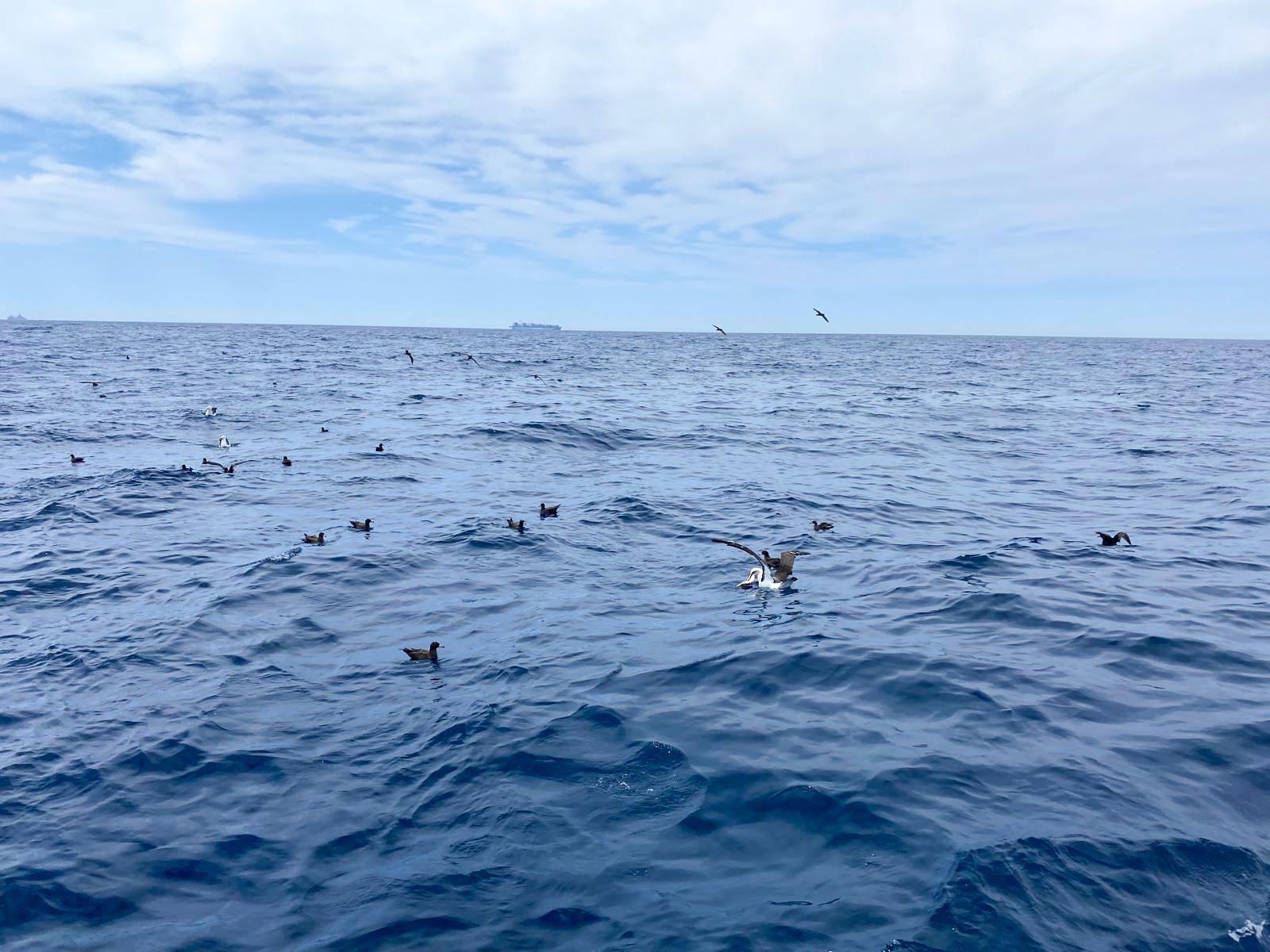
Sydney Pelagic (Buller’s Albatross) © Gregor Tims

Buller’s Albatross © J Mathews
We headed slowly back to port, enjoying numerous Black-browed Albatrosses and abundant Shearwaters on the return journey, along with a breaching Humpback Whale and a Bronze Whaler Shark cruising ominously with its fin exposed above the surface near the boat. We added Pied Cormorant to the tour total near the wharf, and then made the long journey southwards to Kiama.
After checking into the hotel, we had a nice dinner a short walk away, and went to sleep dreaming of Albatrosses.
Day 14
We started the day with a picnic breakfast at Barren Grounds. Unfortunately it was a cold, overcast and windy morning, but several birds appeared in the carpark, including Grey Shrikethrush, Scarlet Honeyeater, Shining Bronze Cuckoo and White-throated Treecreeper. Waking about 50 metres into the reserve, we heard the unmistakeable repeating mellow sequence of a calling Eastern Bristlebird. Wonderfully, this individual defied the species’ unobtrusive reputation and showed brilliantly in a small bush for the whole group to enjoy. We continued deeper into the reserve, suddenly finding ourselves surrounded by calling Southern Emuwrens. Sadly, the wind had picked up considerably and we knew that seeing one would be a real challenge. We waited. And waited. And eventually a stunning Southern Emuwren showed itself to most of the guests flitting about the dense low vegetation. With the weather worsening, we made the decision to continue our journey back north.
We made a brief stop at Maddens Plains near Wollongong, where we heard more Emuwrens and enjoyed the delightful sight of a flowering Banksia thronging with Honeyeaters – New Holland and White-cheeked, along with Little Friarbirds. We could not believe our luck when a striking Square-tailed Kite drifted gently just above our heads.
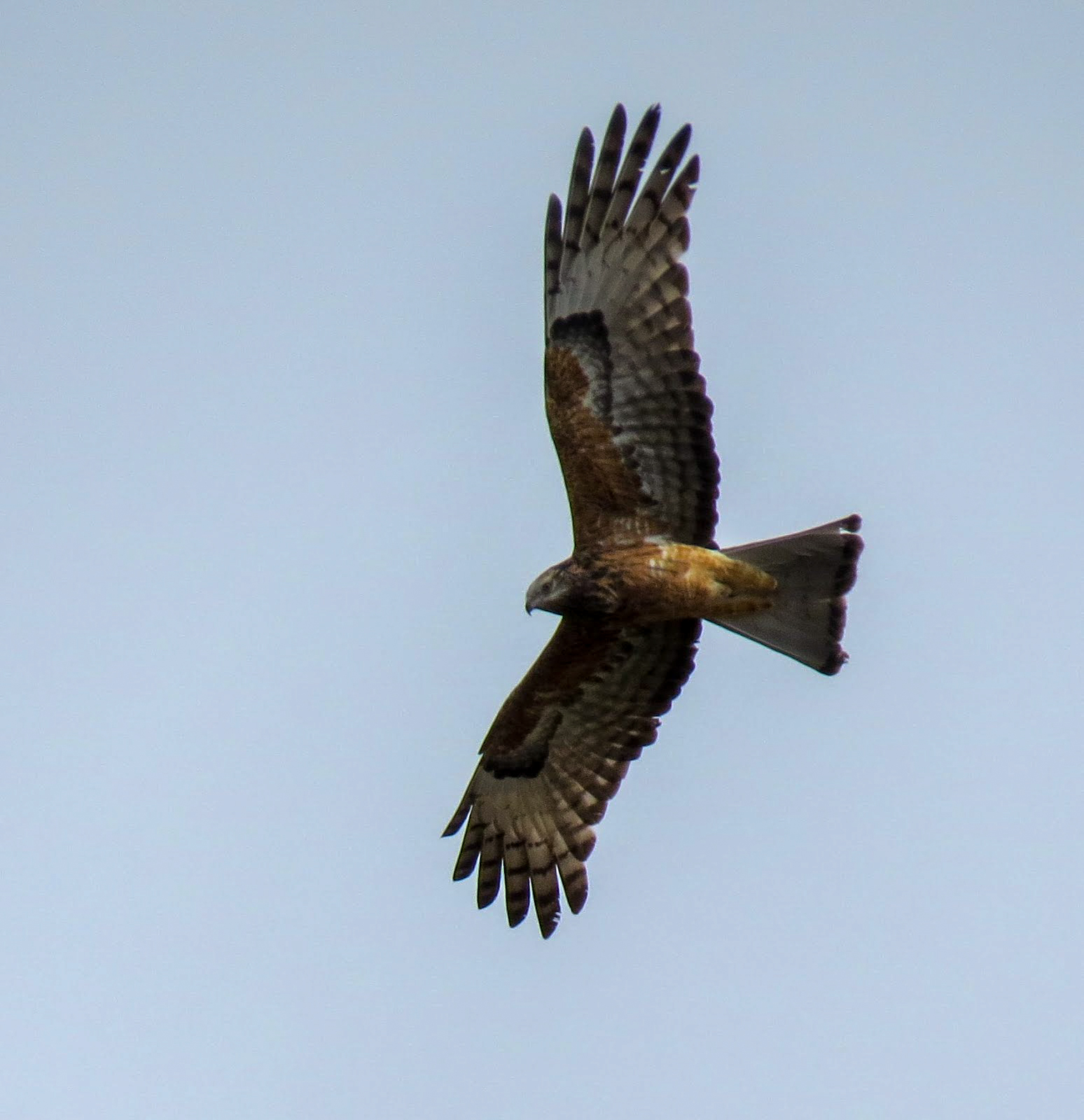
Square-tailed Kite © Gregor Tims
We continued the journey, taking lunch in far west Sydney, where we stopped to explore a small wetland reserve. We had one primary target in mind – and quickly found it, a Yellow-billed Spoonbill feeding in the shallow water, surrounded by cows and accompanied by a single Royal Spoonbill. We enjoyed an array of waterbirds at the reserve, while a group of Red-rumped Parrots thrilled the guests and they passed low overhead. Other highlights at the reserve included finding two beautiful Superb Fairywren chicks just next to the path, brief views of a Rufous Songlark, and more mixed emotions as we observed two European introductions – a Common Blackbird whistling its beautiful melodic song, and the lovely red, white, black and gold of jingling European Goldfinches.
We continued our journey across the Blue Mountains, stopping at the exceptional Lithgow Solid Waste Facility just before reaching our hotel. At the facility, we enjoyed good numbers of some rare and aesthetically striking waterbirds. This included Pink-eared Duck, Australasian Shoveler, Blue-billed Duck and Hoary-headed Grebe. A fine supporting cast included the spectacular array of colours of both Crimson and Eastern Rosellas, and Yellow-tailed Black Cockatoos overhead. Of great excitement to the guests was the plethora of Eastern Grey Kangaroos around the facility and its surrounding fields.
We checked into the motel and enjoyed Little Ravens and Eastern Rosellas in the garden, before taking a well-earned night of sleep.
Day 15
We had an early start, enjoying a hearty breakfast before heading to Capertee Valley, one of Australia’s top birding hotspots. Starting with some roadside birding, exciting species kept appearing. White-winged Triller, Fan-tailed Cuckoo, Eastern Shrike Tit, White-plumed Honeyeater, Dusky Woodswallow and more – it was hard to know where to look! With numerous Superb Fairywrens and Red-browed Finches relegated to a supporting cast, the whole group was having a wonderful morning. Little Lorikeets and Red-rumped Parrots passed overhead, a White-throated Gerygone appeared just next to us and a Mistletoebird afforded exceptional views. Then came an extraordinary moment – an unfamiliar penetrating whistling call came closer and closer. There it was – a Black-eared Cuckoo, just next to us. It was a lifer for both guides and was briefly joined by a second in the same tree.
Reluctantly, we moved on, heading further into the valley. On the way, groups of White-winged Choughs stormed militaristically across the road and through the adjacent vegetation. At our next stop, we quickly found Jacky Winters, and the sky soon filled with Woodswallows. We walked up the road to where we could hear them noisily calling from the treetops. The majority of them were the especially striking White-browed Woodswallows, though we picked out several chocolate-brown Dusky and matte-grey Masked Woodswallows among them. A grand Wedge-tailed Eagle soared over the road, briefly joined by a Nankeen Kestrel, and two Common Bronzewings were found in a nearby field. Rufous Songlarks were calling loudly and soon a raucous group of Musk Lorikeets zoomed overhead. A pair of Brown Treecreepers were unexpectedly feeding on the road while a fast-moving Speckled Warbler flitted about the roadside vegetation.
Sadly, by this point the wind was starting to become powerful and an extraordinary heat was setting in. The car temperature meter recorded it as 36 degrees Celsius.
We headed further into the reserve, frustrated by worsening weather, but doing our utmost to find new birds. We enjoyed roadside views of Buff-rumped and Yellow-rumped Thornbills and a Brown Songlark, along with Swamp and Red-necked Wallabies. A brief stop at Genowlan Bridge in howling wind saw us stumble upon a Diamond Firetail flying up from the ground several times and a Brown Quail scurrying through the grass.
Heading deeper into the National park, we spotted a group of small birds from the moving car. Pulling over, we were delighted to discover that they were Varied Sittellas, a target bird for several members of the group and a great display of convergent evolution, reminding the guests of their familiar Nuthatch species from home despite not being related.
Sadly our attempts to search for Regent Honeyeaters were thwarted by winds that were becoming dangerously strong and what appeared to be an impending storm – a concerning prospect given we were on unsealed roads. A brief stop at a waterhole was a wonderful experience, as numerous Honeyeaters came down for a drink – Yellow-faced, Fuscous, White-naped and the striking Yellow-tufted. Somehow, we came upon a roadside Weebill, Australia’s smallest bird at just 9cm, hanging on to a branch for dear life as the violent winds passed through. We soon came upon a bird nearly as small, a Striated Pardalote, doing the same, which afforded wonderful views for the whole group at just a few metres away.
We decided to head back to the sealed roads and back towards our hotel. With winds dying down, and the unexpected heatwave fading, we made a brief stop at our first stop of the day. We were amazed to hear and then see a Horsfield’s Bronze Cuckoo in the same tree as the Black-eared had been in earlier, shortly followed by a Collared Sparrowhawk overhead. A little further down the road, we were delighted to find three Hooded Robins showing very well by the road. Already satisfied by an amazing day, it became unimaginably even better when we spotted an Echidna ambling along the roadside. It quickly hid itself in the roadside vegetation – but we all enjoyed close-up views of its impressive spines poking out of its hiding spot.
We returned to Lithgow, enjoying another explore of the Solid Waste Facility, before heading on to Lake Wallace, just minutes away from the hotel, and home to pair of Musk Ducks which we quickly located. We also enjoyed close views of Great Crested Grebes here, and a wonderful sighting of two Australian Reed Warblers calling melodiously. The rains then arrived, and the evening became cold. We really had experienced four seasons in a day and we were really for a good night of sleep after another great meal at the motel and the amazing sight of boxing Kangaroos just next door.
Day 16
Our final full day of the trip started with another hearty breakfast at the motel. We said goodbye to the Little Ravens and made our way to Lithgow Blast Furnace Park – the nearby ruins of an old blast furnace. We quickly found the special species that has made the ruins its home, as a bright orange dot appeared on its walls. Some of us immediately thought it was some bright plastic waste, but closer inspection revealed it to be the stunning, deep orange colouring of the male Flame Robin’s breast. We had a wonderful time watching the male and female feeding and flitting between the ruins and the neighbouring fence line. At the adjacent Pillans Wetlands, we were treated to an exceptional view of two Little Grassbirds sunning themselves.
We then continued, via an excellent bird-themed public bathroom, to Hassans Walls, from which we enjoyed great views of the Blue Mountains. We wound our way up to Victoria Falls in the Blue Mountains and continued our excellent run of Robins, with several stunning Scarlet Robins appearing in the carpark. Soon, an incessant chirping began to follow us. It was a very excited Brown-headed Honeyeater, seemingly fascinated by our presence and following us along the track. We found several other songbirds here, before continuing on to Evans Lookout where we enjoyed further exceptional views of the mountains.
Sadly, the the birding had become quiet and further stops in the Blue Mountains revealed little more than Crimson Rosellas, King Parrots, Leaden Flycatchers, Brown and Striated Thornbills, and White-throated Treecreepers. We decided to head to our accommodation in Sydney.
We had a wonderful final dinner together as a group near the hotel, where the guests shared their five birds of the trip.
Day 17
With most guests continuing on for Eagle-Eye’s Tasmania trip, we were up early to head to the airport. It marked the end of two and a half incredible weeks, with 320 birds seen, 5 others heard and 27 mammals recorded, along with other great sightings of Reptiles, Amphibians and Fish.
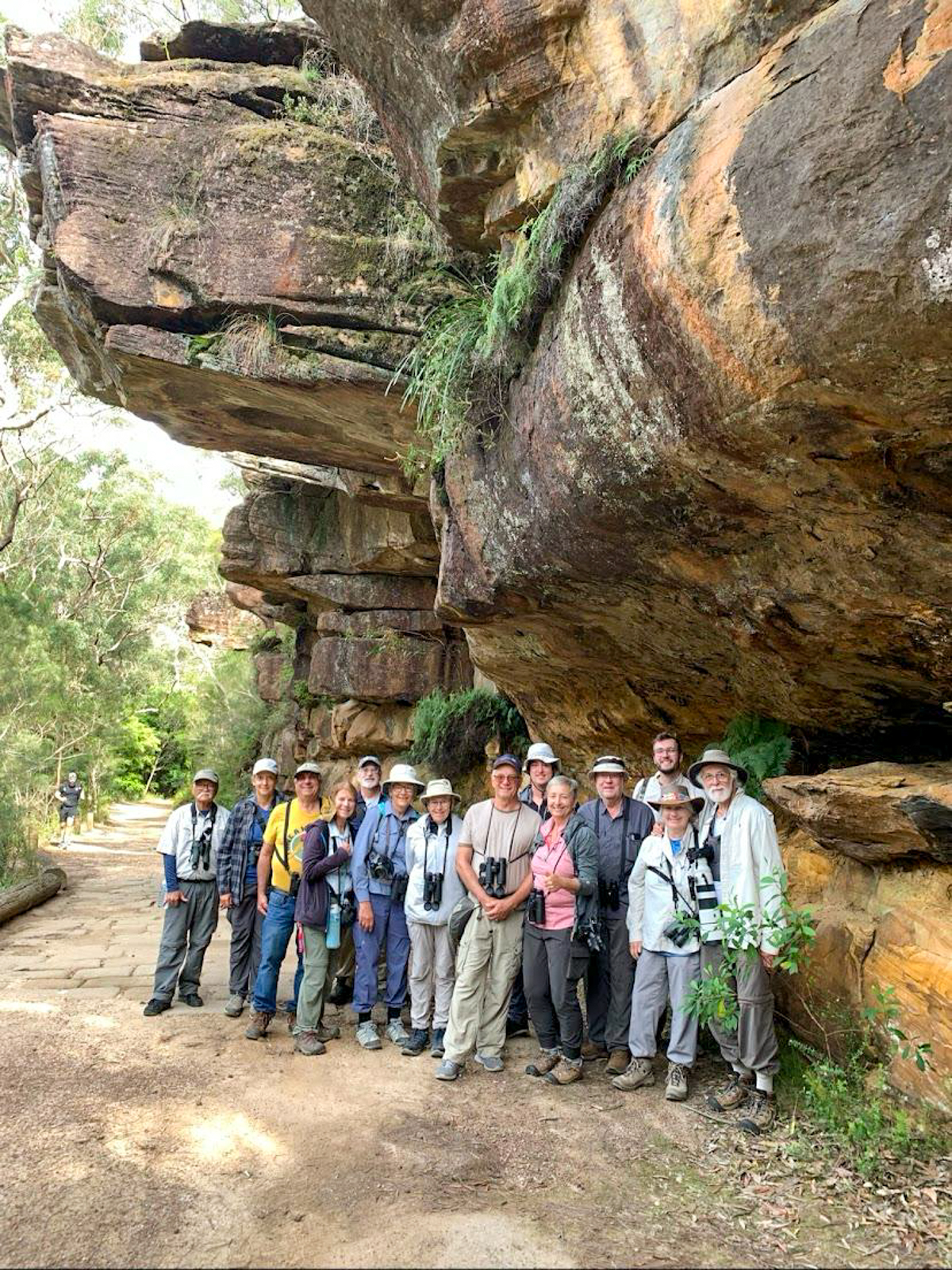
Our group




